




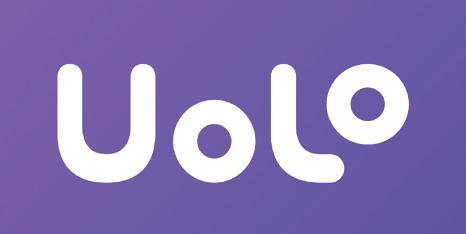
Academic Authors: Jatinder Kaur, Ayushi Jain, Chandani Goyal, Kashika Parnami, Anuj Gupta, Simran Singh
Creative Directors: Bhavna Tripathi, Mangal Singh Rana, Satish
Book Production: Rakesh Kumar Singh, Sakshi Gupta
Project Lead: Jatinder Kaur
VP, Learning: Abhishek Bhatnagar
All products and brand names used in this book are trademarks, registered trademarks or trade names of their respective owners.
© Uolo EdTech Private Limited
First published 2023
Second published 2024
Third published 2025
This book is sold subject to the condition that it shall not by way of trade or otherwise, be lent, resold, hired out, or otherwise circulated without the publisher’s prior written consent in any form of binding or cover other than that in which it is published and without a similar condition including this condition being imposed on the subsequent purchaser and without limiting the rights under copyright reserved above, no part of this publication may be reproduced, stored in or introduced into a retrieval system, or transmitted in any form or by any means, electronic, mechanical, photocopying, recording or otherwise, without the prior written permission of both the copyright owner and the above-mentioned publisher of this book.
Book Title: Tekie Computer Science 3
ISBN: 978-81-978912-4-3
Published by Uolo EdTech Private Limited
Corporate Office Address:
85, Sector 44, Gurugram, Haryana 122003
CIN: U74999DL2017PTC322986
Illustrations and images: www.shutterstock.com, www.stock.adobe.com and www.freepik.com
All suggested use of the internet should be under adult supervision.
Standing at the forefront of the digital and AI revolution, the importance of coding and computational skills has reached unprecedented heights. In today’s professional landscape, whether it is in the fields of medicine, space exploration, education, science, or business, no sector remains untouched by this transformative wave. To thrive in the 21st century, basic computer literacy is no longer sufficient. Learners must evolve into ‘digital natives’ who can fluently read, write, and communicate in the languages that machines and AI comprehend.
Recognising this imperative, the National Education Policy (NEP) 2020 has strongly recommended the integration of coding skills, computational thinking, critical analysis, and problem-solving abilities into the curriculum. Moreover, forward-looking subjects like AI, Data Science, Computer Applications, and IT have been introduced as elective subjects from grade 9 onwards. It wouldn’t be surprising if further transformative measures are taken even at the elementary education level.
Uolo has introduced an innovative 360-degree program for a coding-focused computer science curriculum, known as Tekie, spanning grades 1 to 8. Tekie is a significant stride towards STEM education that aims at making learners future-ready—enabling them with skills needed in the ever-changing, technology-driven, and dynamic 21st-century world.
Tekie adopts a captivating and engaging approach to learning, in line with the recommendations of the National Curriculum Framework (NCF) 2023 and NEP 2020. The curriculum is ingeniously woven into the thrilling adventures of Mel and Conji, fictional characters from the enchanting land of Avora. The Mel and Conji series epitomises a modern method of acquiring computer science knowledge and honing computational thinking skills. The program includes chapters that provide a deeper immersion in computer science that both learners and teachers may find interesting.
Tekie is a technology-empowered curriculum that encompasses the following components:
• Main Content Books: These introduce learners to the theory of computer science and computer tools. Topics in AI are also covered, along with experiential and project-based learning resources.
• Coding Books: Specifically designed to nurture coding skills, this booklet aligns with the experiential and contextual learning approach of the coding curriculum, fostering critical thinking and problemsolving abilities.
• Animated Learning Videos: The program is powered by high-quality animation-based learning videos that deliver learning in an engaging manner.
• Teacher Manual: This valuable resource supports classroom instruction, ensuring that educators effectively deliver the curriculum.
Welcome to the captivating realm of Tekie! We hope you relish this educational journey as it equips you with the tools you need to thrive in the exciting and ever-changing world of the 21st century.
Tekie is an interactive, engaging, and experiential computer science program. It enables learners to attain mastery in computer science theory, new-age computer tools and coding. These are delivered through a storytelling-based coursebook and an experiential learningoriented coding book.
The learning experience is augmented by a digital platform that gives learners access to learning videos and experiential activities and projects that are rooted in the curriculum.
Engaging Textbooks
Comic Stories
Teacher Manual
Test Papers
Additional Projects
Test-paper Generator





Student and Teacher Platform
Learning Videos
Interactive Classroom and Homework Assignments
Byte-size Lesson Modules

The National Education Policy (NEP) 2020, introduced by the Government of India, represents a transformative shift in the country’s education system. It aims to create a more holistic, dynamic and multidisciplinary approach to education. The NEP highlights the need for early development of computational thinking, coding, and digital literacy as vital skills for students’ holistic growth. UOLO is fully committed to actualising the vision of NEP 2020 by meticulously adhering to its outlined recommendations.


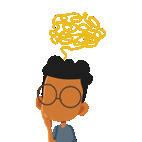

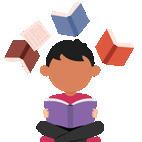

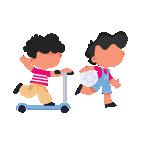



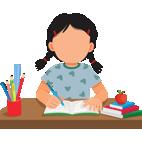
1. Focus on conceptual understanding
2. 21st century skills, values, and dispositions
3. Computational and critical thinking
4. Application in real life
5. Holistic and integrated learning
6. Experiential learning
7. Enjoyable and engaging
8. Artificial intelligence and coding concepts
9. Digital literacy and emerging technologies
10. Factoids on India
Competency-based Education
NEP Pages 12, 17 and 22
Teaching and Learning Pedagogy
NEP Pages 3, 5, 11, 12 and 56
National Pride
NEP Pages 15, 16 and 43
11. Assessment of core concepts and application skills Assessments
NEP Pages 12, 18 and 22
Project-based Learning
Engaging hands-on projects encouraging practical application of computer science and coding
Story-based Approach
Enchanting tales that bring learning themes to life, making education a captivating adventure 5 7
Equipping the students with future-ready skills through exposure to the latest tools and technologies
2 3 4 6 8 9
Engaging activities to deepen students’ understanding and engagement with AI concepts
Test papers designed to evaluate understanding of core concepts and application of skills 3 4 11
Projects on the digital platform to deepen understanding and develop essential practical skills

Invites learners to discuss in small groups and present different perspectives
Story-style learning videos that deliver concepts to students.
Intellectually stimulating questions designed to encourage deep, analytical, critical, and evaluative thought process
Interactive quizzes that reinforce learning and assess students’ understanding
7 9
Think It Through
Probing question related to the concept that arouses curiosity
Tool to create customised assessments that align with the curriculum and help evaluate students’ progress effectively.
7 Enjoyable and engaging 8 Artificial intelligence and coding concepts 9 Digital literacy and emerging technologies 10 Factoids on India 11 Assessment of core concepts and application skills
The National Education Policy (NEP) 2020 outlines essential skills, values, dispositions, and learning approaches necessary for students to thrive in the 21st century. This textbook identifies and incorporates these elements throughout its content, activities, and exercises. Referred to as “NEP Tags”, they are defined as follows:
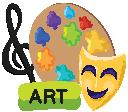


INTEGRATED
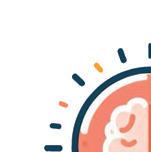



Art Integration
Bringing creativity and fun into learning by combining music, drama, and art with other subjects
Sports Integration
Using games and sports in daily life to enrich computer-related activities
Cross-curricular linkages to make the learning experience more holistic, joyful and meaningful
Critical Thinking
Coding opportunities to apply higher-order skills like algorithmic and computational thinking, and problem-solving
Step-by-step activities to enable learners put theoretical knowledge into practice

SDG
Applied computer science activities related to real-world issues and sustainable development

SEL Social Emotional Learning
Developing the skills to understand and manage emotions, build positive relationships with others and make responsible choices

The curriculum is thoughtfully mapped to introduce tools and technologies at each grade level, ensuring a smooth and progressive learning experience for students. Beginning with basic concepts in junior grades, the curriculum gradually incorporates more advanced tools and concepts in higher grades. This structured approach enables students to build on their knowledge each year, equipping them with essential skills in computer science and technology as they progress from grade 1 through grade 8. By the time they reach the higher grades, students are well-equipped to tackle complex projects, think critically, and apply their skills in real-world scenarios. The curriculum not only fosters technical proficiency but also encourages creativity, problem-solving, and a deeper understanding of the digital world.









































1

We
Theme Page: Lists the chapters covered under a unit



2
We see many things around us. Some things are present in nature like
animals,
and rivers. These are called natural things
Comic Story: To introduce key concepts in a fun way
Did You Know: Interesting facts related to the topic

Discuss: A multi-faceted probing question related to the concept that arouses curiosity

4
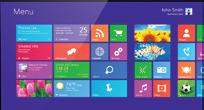


3

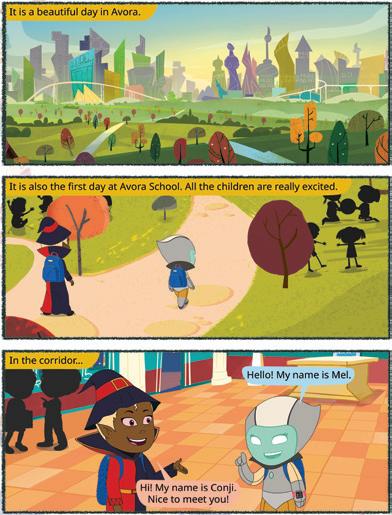





Do It Yourself: Short exercises between the chapter to pause and assess comprehension

Explore More: Short videos to find out more about the topic

















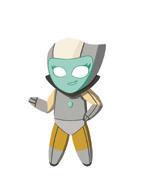







Some things are made by humans. These are called human-made things Buildings, cars, and
are some human-made things.
















































































4. Hold the left mouse button, drag the mouse, and then release the mouse button. You will see that an oval has been drawn. Oval

After selecting the shape, go to the drawing area.

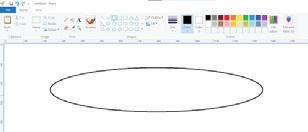
Project-based Learning: A project-based learning approach employed to foster an engaging and interactive learning experience Points to Remember: Summary of the chapter
Chapter Checkup: Chapter-end practice exercises aligned to different levels of Bloom’s Taxonomy

Apply your learning: Intellectually stimulating questions designed for higher-order thinking and analysis
Have you ever given a command to the speaker at your home to play a song, and it plays it?
Do you know what these speakers are known as?


These special speakers, which follow your voice commands, are smart speakers Smart speakers can do this because of AI.
What is AI?





Artificial Intelligence: Chapters on Artificial Intelligence to explore the fundamentals of AI, including its principles and applications in various fields
AI stands for Artificial Intelligence It gives machines the ability to learn and do things on their own, just like humans do
AI Around Us
• Talking Toys: Some toys use AI to understand your voice and respond with sounds, songs, or even short sentences.

A. Fill in the blanks.
• Robot Helpers: These machines help us with daily tasks at home. They can clean floors, cook food, etc. They do work in the same way as a human does.
Fun with AI: Engaging AI activities designed to help students explore and apply AI concepts in practical ways




AI devices are all around us. There are many types of machines that use Artificial Intelligence (AI) to perform tasks or respond to us. Some examples of such AI devices are:

• Smart Speakers: These speakers respond to your voice commands. They use AI to understand your voice commands, like when you ask them to play music or tell you a story.
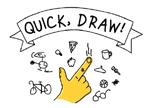
• Selfie Magic: Some phones use AI to edit your selfies. The AI can adjust lighting, smooth out backgrounds, or add fun filters.


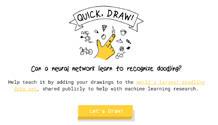

Test Paper 1 (Based on Chapters 1 to 3)
Test Papers: Designed to evaluate understanding of core concepts and application of skills
1 Things that are present in nature are called
2 Some machines need to work.
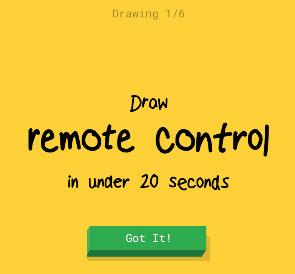
3 Computers are used in to keep information of patients.
4 At restaurants, computers are used to order and pay for
B. Tick () the correct answer.
1 Which of the following is a human-made thing?
a Mountains b Trees
c Cars d Animals
2 Which machine helps us keep our food fresh?
a Refrigerator












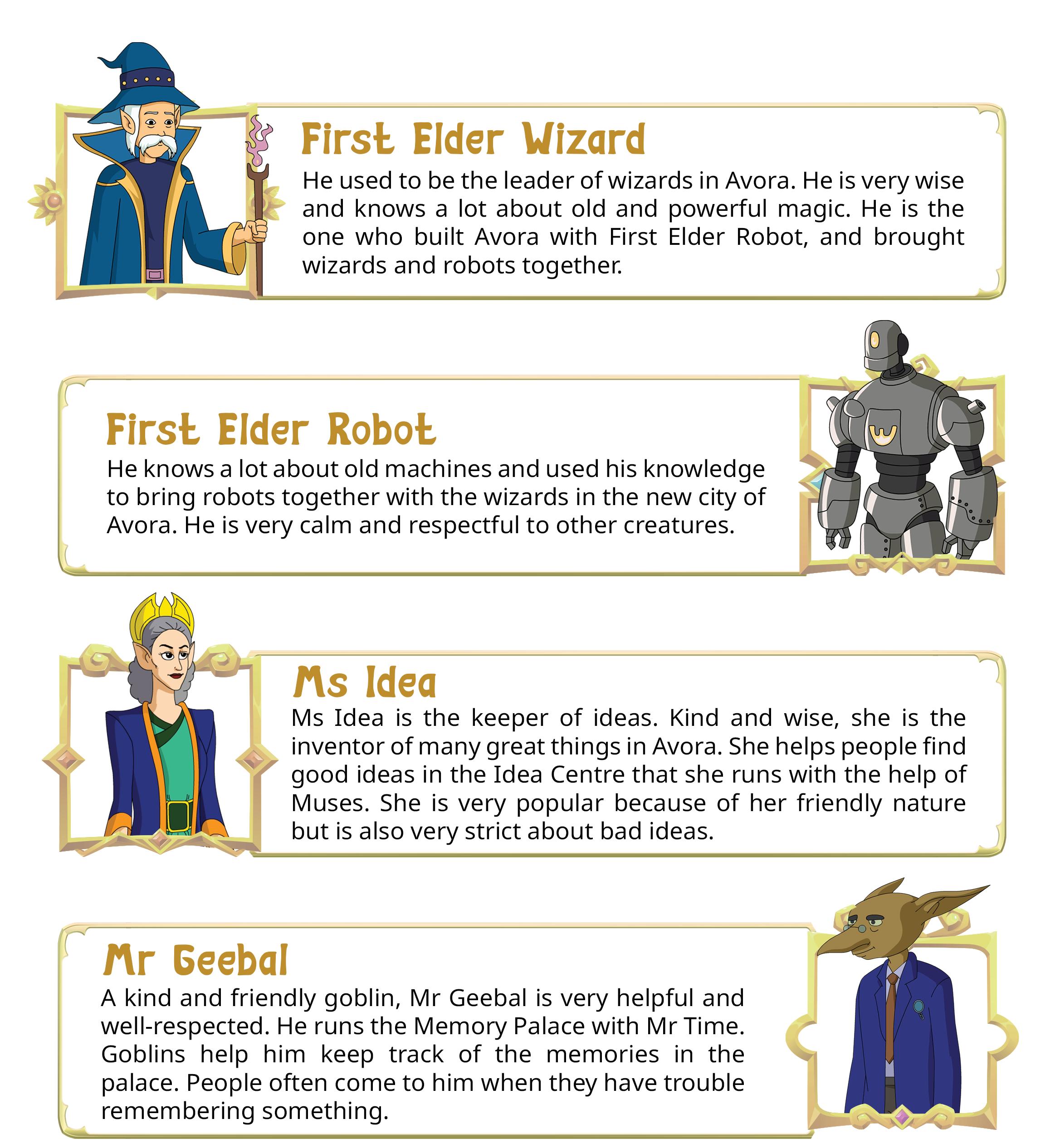


•
•
•
• Typing Text in a Document
•
•
•
• Editing
• Selecting Text
• Moving Text
• Deleting Text
• Undo



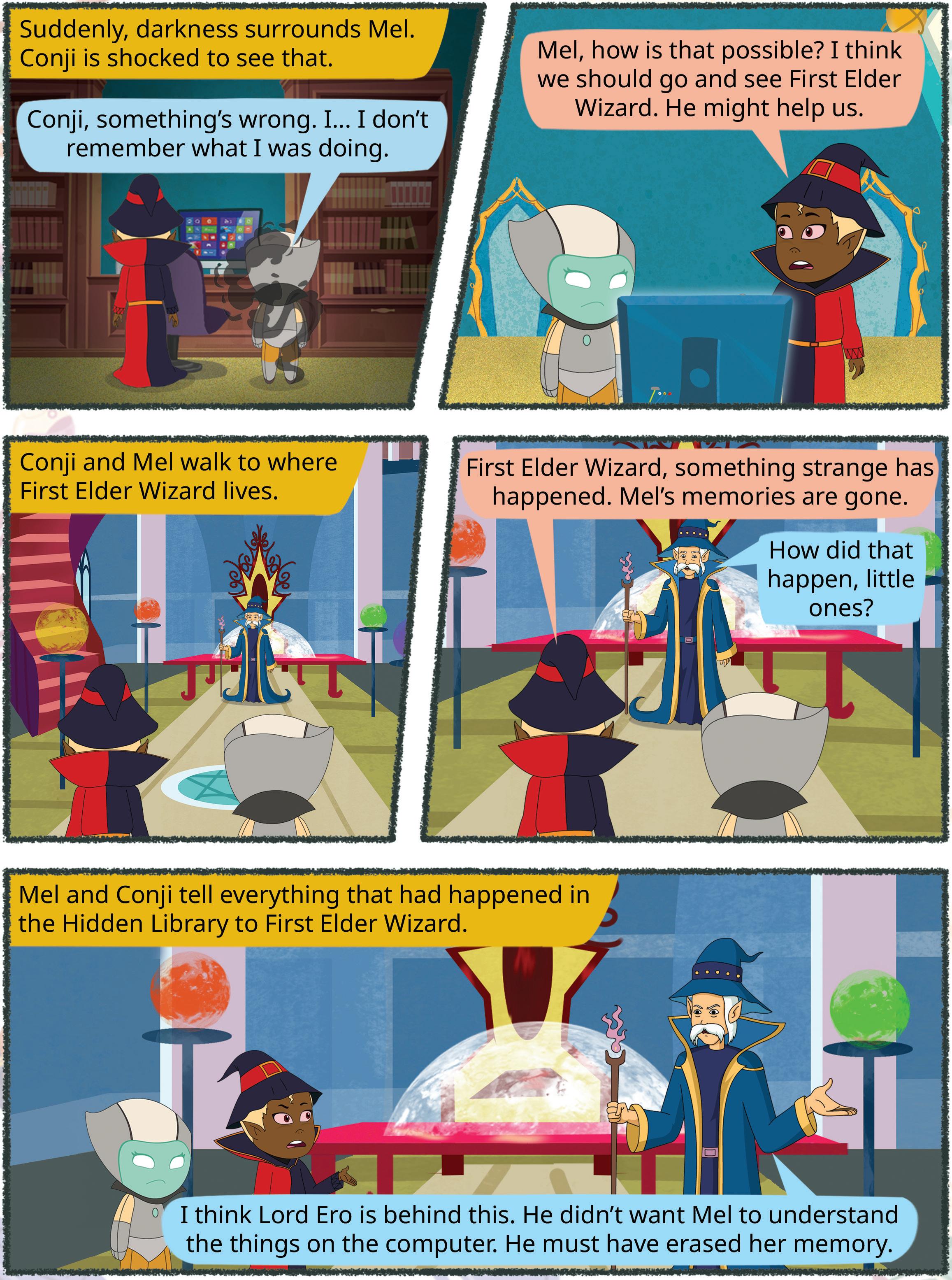


In today’s world, computers have become a very important part of our lives. We see them at home, school, hospitals, etc. It helps us do many things, like play games, write letters, and do the homework. They are used for processing and storing information, solving problems, etc.
In schools, computers are used to teach students about different subjects. In businesses, computers are used to calculate profit and loss. In homes, computers are used for entertainment, like playing games and watching films.
Computers can be classified into different categories based on their size, speed, storage capacity, and cost.
Types of Computers
Microcomputers Minicomputers
Mainframe computers
Supercomputers
Microcomputers are small computers that are used by individuals. They are called personal computers (PCs). They are used in homes, schools, offices, shops, and banks. They can be used for different things, such as playing games, writing documents, and doing research.
Microcomputers are available in different forms.
1. Desktops: They have different parts, such as a monitor, the CPU, a keyboard, and a mouse. All these parts are connected to work together.















2. Laptops: These are small computers with a variety of screen sizes. You can keep them on your lap. They run on batteries, and you can carry them around.
3. Tablet: Tablets are smaller than laptops but bigger than phones. They have touch screens instead of keyboards or mouse.
4. Smartphones: Smartphones are tiny computers that you can hold in your hand. They can do a lot of things, like calling your friends, sending messages, playing games, taking pictures, and showing you the maps to find the places.
Did You Know?
The first personal computer was called the Altair 8800. It came out in 1975 and was made of circuit boards.

These computers are bigger and faster, but they are more expensive than microcomputers. They are used by multiple people at once in places like banks and universities. Today, they are often called small or mid-size servers, like the PDP-8, HP 2100, Honeywell 316, and TI-990.
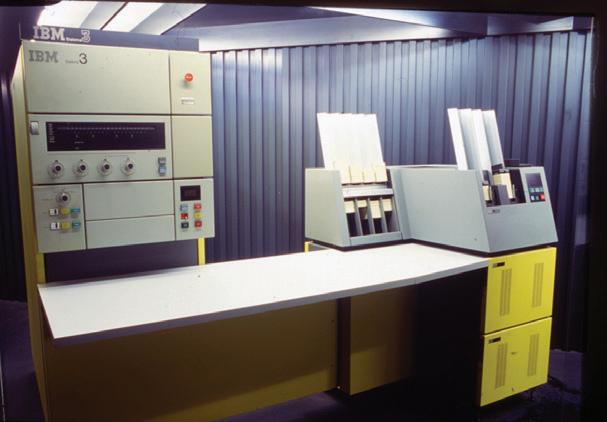
These computers are very powerful, large in size, and efficient. They are very expensive. They are used in large organisations like banks and airports. Many people can use them at the same time.
Some examples are the IBM Z series, PDP-10, and System Z10.


Supercomputers are the largest and fastest of all types of computers. They are used in large organisations for tasks such as weather forecasting and rocket launching.
PARAM 8000 was India’s first supercomputer, introduced in 1991.

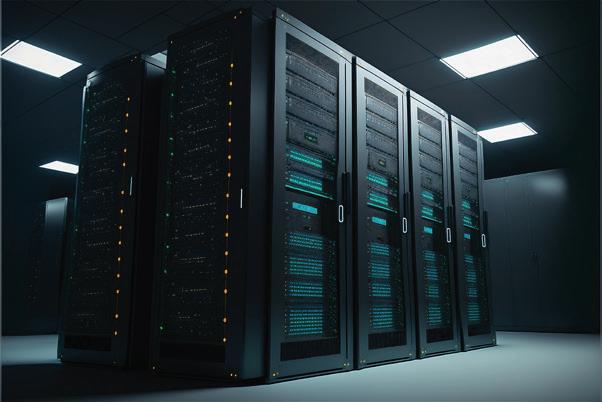
Are supercomputers only used by big companies?

Computer hardware refers to the physical parts of a computer that you can touch or feel. Examples of computer hardware includes a monitor, keyboard, mouse, CPU, printer, speakers, etc. Let us learn about the hardware devices in detail.
A monitor looks like a TV screen. It shows you all the things that you do on the computer, such as playing games, drawing, or writing stories. A monitor is also known as a VDU (Visual Display Unit).
There are three types of monitors.
1. Cathode Ray Tube (CRT) Monitor: CRT monitors are big in size and have a curved display. They consume a large amount of power.


2. Liquid Crystal Display (LCD) Monitor: The LCD has a flat screen. LCD monitors are more energy-efficient than CRT monitors.
3. Light Emitting Diode (LED) Monitor: The LED monitors are thinner and lighter in weight as compared to CRT monitors. LED monitors consume less power than LCD monitors.
Central Processing Unit (CPU) is a processing device. A computer transfers information through the CPU. It is the brain of the computer that manages all the calculations and programs. The CPU chip lies inside the computer cabinet.
The CPU has three main parts. Let us learn about them.


1. Memory Unit (MU): It stores data and instructions given to a computer.
2. Control Unit (CU): It controls and manages all the parts of a computer.
3. Arithmetic Logic Unit (ALU): It performs all the mathematical calculations, like addition, subtraction, multiplication, division, as well as logical operations.
A computer keyboard is an input device that allows us to enter letters, numbers, and other symbols (these are called special characters) into a computer. It is used to type data and instructions into the computer. A standard keyboard typically has 104 keys.
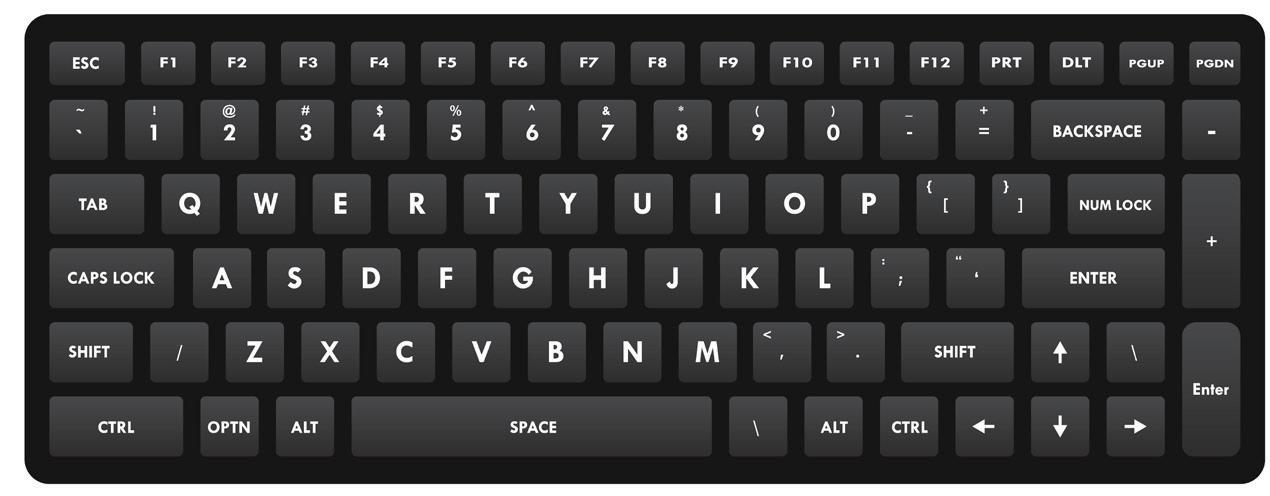
A mouse is an input device used for pointing objects. It is used to point, click, and move various objects on the screen.

A touchscreen is a display device that allows us to interact with a computer by touching the screen. Devices like tablets and smartphones have a touchscreen. You can work on a touchscreen using your finger tips.
A scanner is an input device that scans text or pictures printed on paper and converts the information into a digital copy.
A printer is an output device that makes copies of text or pictures from a computer onto a paper. This paper copy is called a hard copy.


Did You Know?
A speaker is an output device. It is used for listening to music and other sounds played by the computer.
A light pen is an input device. It is also known as a pointing device. It looks like a normal pen. It is used to draw and write anything on the screen. Whatever you draw or write, it will be displayed on the screen.
















In around 1440, the goldsmith Johannes Gutenberg invented the movable-type printing press, which started the printing revolution.

A joystick, also known as an input and pointing device, is used for playing games.
A microphone is an input device that records your voice and various sounds into a computer. It also allows you to talk with your family and friends over the internet.
A CD is a storage device. It is a removable disc that is round, flat, and shiny. It can store a limited amount of data.
A pen drive is very small in size, which makes it portable. It can store and transfer information from one computer to another.
RAM stands for Random Access Memory. It stores the information temporarily on a computer. It allows the computer to run programs and access data quickly.
The motherboard is the backbone of a computer system. It provides the physical structure and electrical connections that allow the other components to work together.
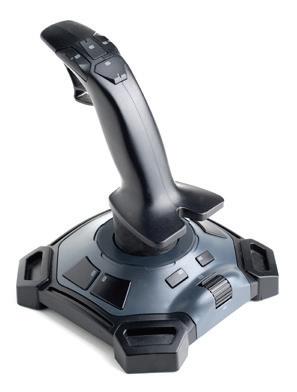



















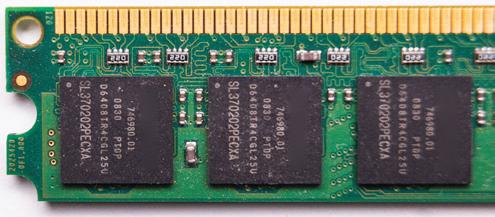
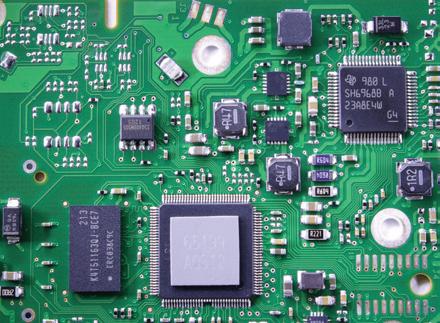
A hard disk is a device that can store large amounts of data and information used by computers. A hard disk is present inside the CPU cabinet. Nowadays, external hard disks are also available.


Do you want to know more about how the CPU works?
Scan here to find out!
Do It Yourself 1A

1 Which of the following is used to point, click, and move across various on-screen objects?

2 Which of the following stores the information temporarily on a computer?

There are two types of software:














Software is the part of a computer that cannot be touched. Software is a set of instructions or programs given to the computer to do some work.
System software controls the overall working of a computer. It manages all the input and output operations of the computer.
For example, the operating system is a part of the system software that makes a computer run.


Do you want to know how operating systems work in computers? Scan here to find out!
The software that helps you to do specific tasks is known as application software. Examples: Paint, Google Chrome, and Microsoft Office.
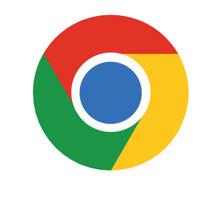
Let us now learn about the IPO cycle. Is software used only on computers?
These three processes are completed by every computer: Input–Process–Output.

The data and instructions that you enter using an input device, like a keyboard or a mouse, into a computer are called input. You can enter numbers, words, or pictures as input.
After entering data and instructions into a computer, the CPU works on the input to provide you with meaningful information. This is called processing.

The meaningful information that you get after processing is known as the output.
Let us understand the Input-Process-Output (IPO) cycle using a real-life example: making pancakes.
Here are the steps to cook pancakes:
Input
Mix flour, sugar, salt, and milk together
Process
Pour the batter on the pan and cook on both sides
Output
Serve pancakes with any toppings
1 Identify the Input, Process, and Output in the procedure of making a boat.


2 Match the following.
Column A
Add the given numbers: 7, 5, 6 Do It Yourself 1B
Column B
Input Answer = 18
Output
Process
= 7 + 5 + 6
1 Laptops, desktop PCs, tablets, and smartphones are microcomputers.
2 Minicomputers are used by multiple people at once in places like banks and universities.
3 Computer hardware refers to the physical parts of a computer that you can touch or feel.
4 There are three main components of the CPU: MU, ALU, and CU.
5 A keyboard is an input device that allows us to enter letters, numbers, and other symbols into a computer.
6 A standard keyboard has 104 keys.
7 A mouse is an input device used for pointing objects. It is used to point, click, and move various objects on the screen.
8 A hard disk is a storage device used to store large amounts of data.
9 Software is that part of a computer that cannot be touched.
10 Software is of two types: system software and application software.
11 Input–Process–Output is how computers work. They take input, process it, and show the results.
A. Fill in the blanks.
1 refers to the parts of a computer system that can be touched or felt.
2 The final step in the IPO cycle is known as .
3 A is an output device that makes copies of text or pictures from a computer onto a paper.
4 A joystick is an device used for playing games.
5 The is the brain of a computer.
B. Tick () the correct option.
1 What is a set of programs called?
a Software b Information
c Pen drive d Joystick

2 Which of the following are types of monitors?
a CRT b LCD
c LED d All of these
3 Which device allows you to hear music and sounds on a computer?
a Screen b Microphones
c Mouse d Speakers
4 Which type of software is responsible for managing computer input and output?
a System software
b Application software
c Hardware d Internet browser
5 What type of computer is commonly found in homes, schools, and offices?
a Mainframe computer
c Microcomputer
C. Who am I?
1 I am a part of the CPU that performs all the mathematical calculations.
b Minicomputer
d Supercomputer
2 I am a device that prints what is on a computer screen onto paper.
3 I am a small hand-held device that you use to point and click on a computer screen.
4 I am a type of screen that you can touch to interact with a computer or a device.
5 I record your voice and various other sounds on a computer.
D. Write T for True and F for False.
1 A mouse is not a pointing device.
2 RAM stores the information temporarily on a computer.
3 Light pens are used for listening to the music and sound from the computer.
4 A monitor is also called a VDU (Visual Display Unit).
5 A scanner scans the text printed on paper and converts it into a digital copy.
E. Answer the following questions.
1 What is RAM?
2 Name the different types of monitors.
3 What is a CPU?
4 Give an example of the Input–Process–Output cycle.
5 Define software. What are its types?
F. Apply your learning.
1 Rahul wants to play a game on his computer. What type of input device can he use for this?
2 Sakshi is typing a school essay on her computer. Which hardware device is she using for the input?

3 Rohit is using a microphone for a video call. What type of hardware device is the microphone, and what is its primary function?
4 Suhani’s mother is operating a device using her finger tips. Name the device.
5 Shivam wants to send a soft copy of the assignment questions to his school friend. But he has those questions written in the school diary. Name the device he must use to create a soft copy of the document.



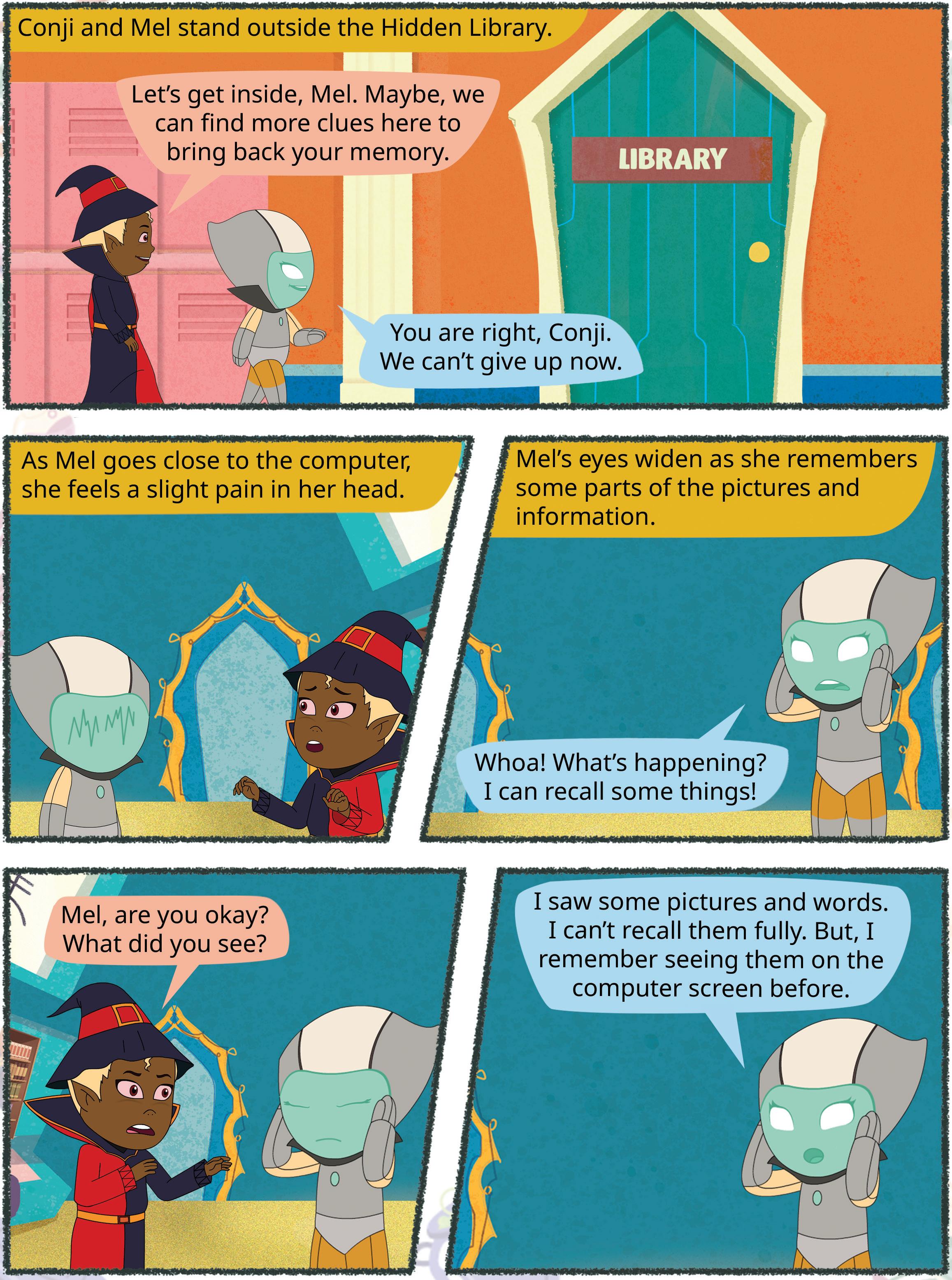




Students, you must have gone to the library and seen that it is the librarian who issues books to you. The librarian is like the manager of the library. He/she organises books, helps people find what they need, and makes sure everything runs smoothly.
Similarly, a computer has a special program known as the operating system that manages various tasks, helps us search for files and apps, and makes sure that the computer runs smoothly.
The operating system manages computer hardware and software. It provides an interface to the users through which they communicate with the computer. It handles tasks like managing devices, allocating memory, managing programs, and many more.
The first operating system was created in the 1950s. Did You Know?

A user interface is a bridge between you and the computer system. Let us say you want to play music on your computer. How would you do it?




















Hardware
Think and Tell
Which other devices do you think have an OS?
You will give instructions to the computer by pressing the mouse buttons or pressing the keys on the keyboard to play music. The icons and buttons you click using the mouse are a part of the user interface.

There are two types of user interfaces:
1. Character User Interface (CUI): It involves typing text-based commands using the keyboard to interact with a computer.
2. Graphical User Interface (GUI): It is a visual way for users to interact with a computer by using pictures like menus, icons, and buttons. These interfaces are much easier to use than CUI interfaces. Windows is an example of a GUI.
Let us learn about the differences between CUI and GUI.
CUI stands for Character User Interface. GUI stands for Graphical User interface. It works on text-based commands. It works on icons and buttons. No text commands are needed. It works fast. It works slowly. It is difficult to use. It is easy to use and very user-friendly.
Examples: DOS (Disk Operating System), Unix Shell, and Terminal.
Examples: Windows, macOS.
1 Write C for CUI and G for GUI in the boxes. Do It Yourself 2A
2 Write two examples of GUI and CUI.
GUI: CUI:

Windows 10 is a popular operating system. It was developed by Microsoft Corporation and released on July 29, 2015. It is mainly built to be used in computers and laptops.
Let us learn about some of the features of Windows 10.

1. Windows 10 provides a Graphical User Interface (GUI).
2. It makes the interaction between the computer and the user easy.
3. It allows us to perform many tasks at the same time. For example, you can play music on the computer while playing a game.
4. It allows us to give all the commands to the computer by clicking on the images and the menu.
After switching on the computer, the screen that is visible, is called the desktop. The desktop is a collection of various components.
Let us learn about these components.

The small graphical symbols or images that represent files, apps, or folders are called icons. We will learn more about files in the next chapter.



The taskbar is present at the bottom of the screen. It allows you to manage the programs that you are using. It has the following components:
Start Button: It is located at the bottom left of the desktop screen. When we click on the Start button, the Start Menu opens. The Start Menu shows all the apps present on your computer.
Search Bar: It is a text box that is located on the taskbar at the bottom of the desktop. It is used to search for files, apps, and settings on your computer.
Task View Button: It shows you a list of all the programs and windows that you have opened.
Notification Area: The notification area is present on the right side of the taskbar. It shows icons for programs and notifications. It also shows the date and time on the computer.



We can perform different types of operations on the desktop, like arranging icons, opening apps, sorting icons, etc. Let us learn about these operations.

Steps to open an application in Windows 10:
1. Click on the Start button. The Start menu will open.
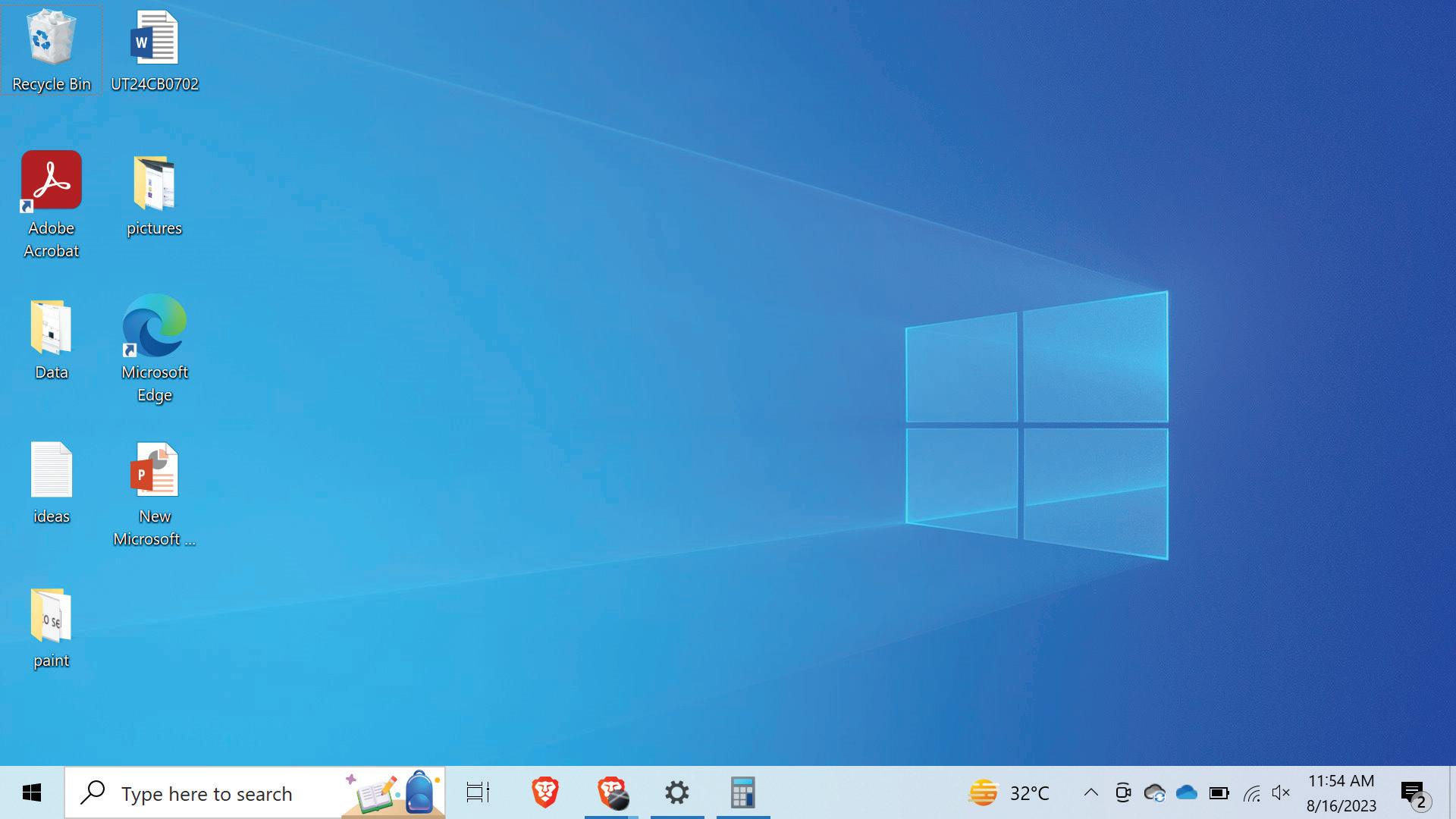

Start Button
2. Click on the application that you want to open from the Start menu.

3. The application will open on the screen.

Think and Tell
Can you give an example of an icon you might see on your desktop?

As you arrange the things on your study table to make it neat and clean, you can also do the same with icons on the desktop. Let us learn how to arrange icons on the desktop.
Steps to arrange desktop icons:
1. Right-click on an empty area on the desktop.
2. Click on the View option, then click on the Auto arrange icons option on the list.
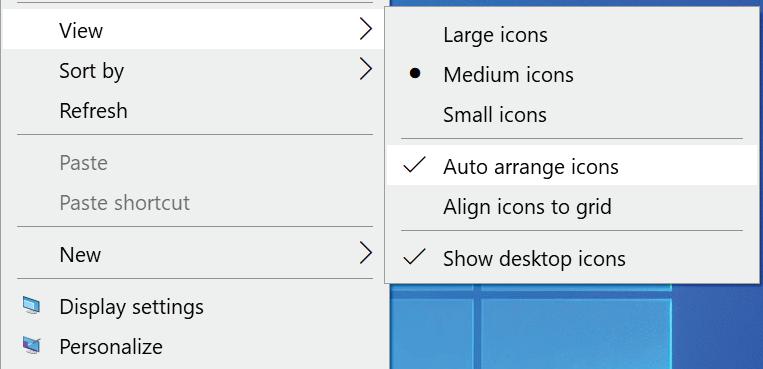
This will arrange all the icons in an organised way.

Before applying Auto arrange


After applying Auto arrange
What is the purpose of the search button on the taskbar?


Sorting icons means arranging them in a specific order. Steps to sort the icons:
1. Right-click on an empty space on your desktop. A list will pop up.
2. Click on the Sort by option.
3. Choose how you want to sort your icons. Your icons will be sorted.

Here are some options of how you can sort your icons:
Sort by Name
This will sort your icons alphabetically.
Sort by Size
This will sort your icons by their file size, from smallest to largest.
Sort by Item Type
This will sort your icons by their file type, such as .exe, .jpg, or .mp3.
Sort by Date Modified
This will sort your icons by the date they were last modified, from most recently modified to least recently modified.





Windows 10 comes with a built-in feature called Windows Spotlight that changes your background every day. Scan here to learn more!




The desktop has an image behind all the elements. This image is called the background image or wallpaper.
Let us learn how we can change the wallpaper.
1. Right-click on the desktop.
2. Select the Personalize option.
3. Select the Background option.
4. Choose a picture or browse for other options.


The picture will be set as your desktop background instantly.
The screen saver is an image which pops up on the computer screen whenever a computer is left idle for a certain period of time.
Steps to change a screen saver:
1. Right-click on the desktop.

2. Choose the Personalize option.
3. Click on the Screen Saver Settings.
4. Choose a screensaver from the Screen saver options.
5. Click Apply and then OK to save your changes.

Do It Yourself 2B
Match the following.
Column A Column B




To search on the computer
To see the notifications
To change the desktop background
To view the list of programs opened
Windows 11 is a GUI-based operating system developed by Microsoft. It makes the interaction between the computer and the user easy, just like Windows 10. Let us learn more about it.
Some of the key features of Windows 11 are:
New User Interface: Windows 11 has a fresh and new look. It is more user friendly. The Start menu is in the middle of the task bar.
Virtual Desktops: Windows 11 has the feature of multiple desktops to help keep our work organised.
Snap Layouts: This feature let us easily arrange and organise open windows on our screen. We can see multiple things at once.
Microsoft Teams: This app is built into Windows 11. It lets you talk and chat with friends and family.
Security: Windows 11 has strong security features to protect our computer from viruses and other threats.
Windows 11 comes with various components that make it a powerful and user-friendly operating system.


Follow the given steps to open an application.
1. Click on the Start button.
Start Button: In Windows 11, the Start button is located in the centre of the taskbar by default, making it easy to access. When you click on it, a new Start menu opens.
Start Menu: The Start menu is divided into two sections: the Pinned and Recommended section and a search bar at the top.
• Pinned Apps: The upper part of the Start menu shows pinned apps, allowing you to access the most-used applications quickly.
• Recommended Apps: Below the pinned apps, there is a “Recommended” section that shows recently used files and apps, making it easier to resume tasks.
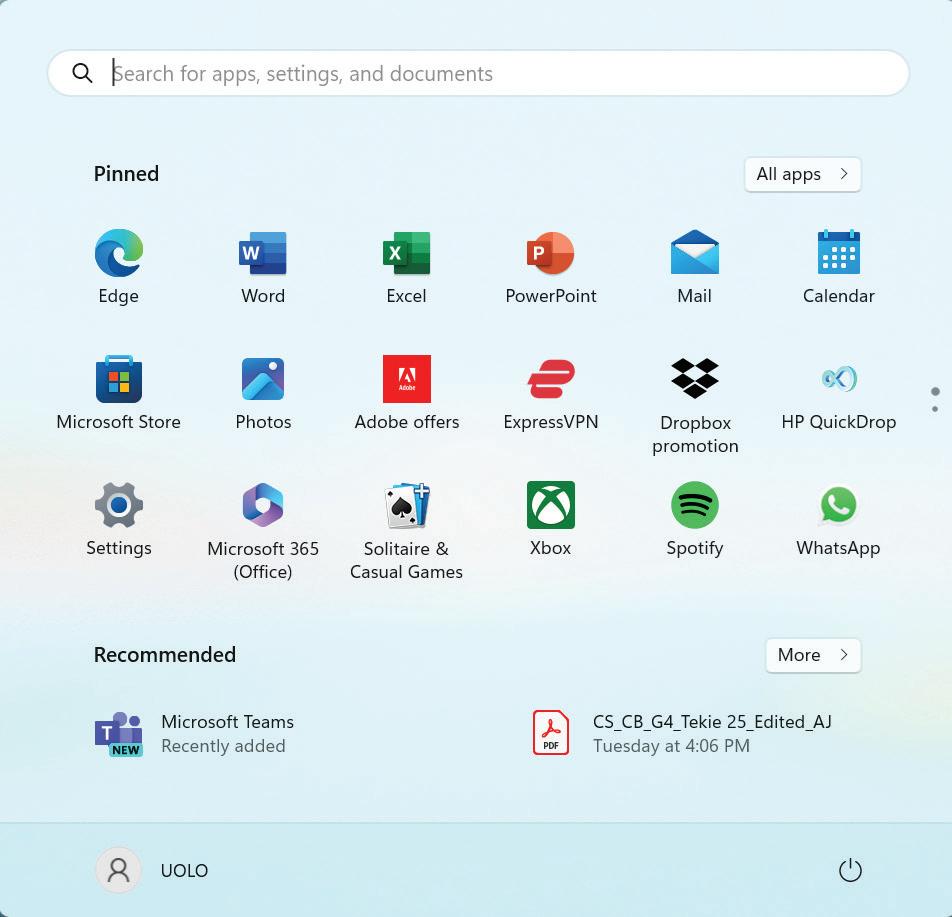
2. Click on the application that you want to open from the Start menu. If you don’t find it in the Pinned or Recommended section, you can click on “All apps” or use the search bar to find it.
3. The application will open on the screen.
1 An operating system (OS) is a program that manages various tasks, helps us search for files and apps, and makes sure that the computer runs smoothly.
2 A user interface is a bridge between you and the computer system.
3 Windows 10 is a popular operating system that can be installed on a variety of devices, like desktops, laptops, tablets, etc.
4 The Start button is a button in the taskbar that opens the Start Menu.
5 Icons are pictures on the desktop that represent apps, files, or folders.
6 Sorting icons means arranging them in a specific order.
7 The desktop has an image behind all the elements. This image is called the background image or wallpaper.
8 The screen saver is an image which pops up on the computer screen whenever a computer is left idle for a certain period of time.
A. Fill in the blanks.
1 An operating system is a that makes sure that the computer runs smoothly.
2 An is a bridge between you and the computer system.
3 The bar at the bottom of the screen is called the .
4 are images on the desktop that represent apps, files, or folders.
5 The bar allows you to search for files and programs on the computer.
B. Tick () the correct option.
1 Which sorting option sorts your icons by the date they were last modified?
a Size
c Type
b Date modified
d Name
2 What does the Notification Area on the taskbar show?
a Notifications to see
c Start button
b Games to play
d Music playlists

3 What does the Start Menu contain?
a All apps present on the computer
c Start button only
4 What does the taskbar in Windows 10 help you do?
a Control the computer’s temperature
c Manage the programs you are using
5 How do you open the screen saver settings?
b Only calculator
d Wallpapers
b Arrange icons on the desktop
d Change the desktop wallpaper
a Right-click on the desktop and select the Personalize option.
b Right-click on the desktop and select the Screen Saver option.
c Right-click on the desktop and select the View option.
d None of the above.
C. Who am I?
1 Match the columns:
I find a file, program, or setting on your computer.
I change the date and time on your computer.
I open the Start Menu.



I am a popular operating system. 2024

D. Write T for True and F for False.
1 A user interface is a bridge between a user and the computer.
2 Changing the wallpaper is the same as changing the screensaver on the desktop.
3 The Search bar is used to find files, programs, settings, etc., on the computer.
4 The taskbar is at the bottom of the desktop screen.
E. Answer the following questions.
1 Define operating system.
2 What is a taskbar?
3 Write the names of the different types of interfaces.
4 Write any one feature of Windows 10.
F. Apply your learning.
1 Mia wants to change the wallpaper on her desktop. Name the option she should select after right-clicking on the desktop.
2 Rachit left his computer idle while he was on a call. When he returns, he sees an image pops up on the computer screen. What is this image called?
3 Aastha wants to arrange her desktop icons in alphabetical order. How can she do it?




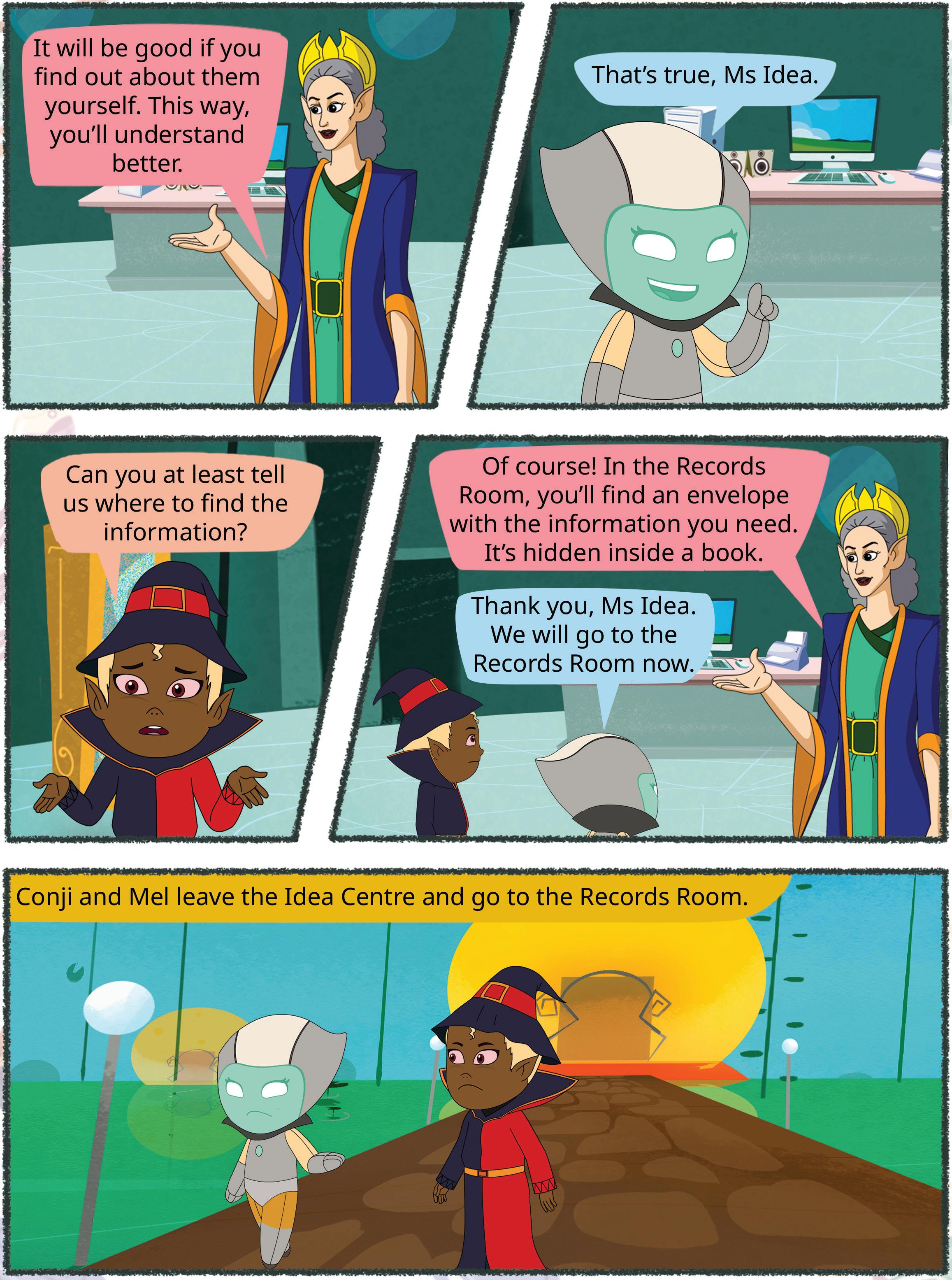



Look at this box. It has so many toys in it. There is a teddy bear, a toy drum, and a toy car in it.
Each toy has a name. So, if anyone asks you for the teddy bear, you can easily find it in the box.
In the same way, our computer has many files in it and each file has a name.
A file is a collection of information.
It is stored on a computer. Files can hold text, pictures, songs, videos, and much more.
Just like we keep our toys in the toy box. We can keep our files on our computer using folders.
A folder is a container that can store files.
Folders can be used to organise files and make them easier to find. They act as holders where you can group similar files together.
We can type text in a text file. Let us learn how to create a text file.
Steps to create a file:
1. Right-click on the desktop.
2. Position the mouse pointer over the New option.
3. Click on the Text Document option. A new text file will be created with a default name New Text Document.
This image that we see here is called an icon.


An icon is an image on the computer screen that represents a file or a folder.


A file can be stored in a folder on the computer. Let us learn how to create a folder.
Steps to create a folder:
1. Right-click on the desktop.
2. Place the mouse pointer over the New option.
3. Click on the Folder option. A new folder will be created with a default name New Folder.


Do you think it is possible to create a folder inside

1 Write T for True and F for False.
a A file stores information.
b A file acts as a container for the folders.
c We can right-click on the desktop to create a new folder.
2 Number the following steps to create a folder on the desktop.
Give it a name. Click on the Folder option. Position the mouse pointer over the New option. Right-click on the desktop.
We learnt how to create a file. Now, let us learn how to open the file we have created.
Steps to open a file:
1. Go to the desktop.
2. Double-click on the file icon to open it.
Another way to open a file:
1. Right-click on the file.
2. Select the Open option.
There is yet another way to open a file:
1. Select the file using the left mouse button.
2. Now, press the Enter key on the keyboard. The file will open.


Double-click on the file


Right-click on the file
Now, that we have opened the text file, let us type something in the file.
Steps to type:
1. Click on the white area. A blinking black line will appear. It is called the cursor. This is where we can type.


2. Use the keyboard to type text here.

Once we have completed typing, we can save the file. If we save the file, the text we typed will be saved, even if we turn off the computer. We can open the file later and see our document again.
Steps to save a new file:
1. Click on the File menu.
2. Click on the Save option.
Click on the File menu.

Click on the Save option.
3. The Save As dialog box will open.

4. Type the desired name and click on the Save button. Your information will be saved in the file.
1 A file is a collection of information.
2 Files can hold text, pictures, songs, videos, and much more.
3 A folder is a container that stores files.
4 Folders can be used to organise files and make it easier to find them.
5 We can create a text file to type something.
6 For opening a file, go to the desktop and double-click the file icon.
7 For saving a file, click on the File menu → Save option.
A. Fill in the blanks.
Hints folders computer save information files
1 A file is a collection of .
2 can hold text, pictures, songs, videos, and much more.
3 are containers which can store files.
4 A file is a collection of information that is stored on a .
5 You should a file after typing so that you can open it later.
B. Tick () the correct option.
1 What is the blinking black line that appears on the white area called?
a Cursor
b Mouse pointer
c Folder d Icon
2 How are files organised on a computer?
a In tiffin boxes
c In the trash bin
3 What is a folder on a computer?
a A type of file
c A computer program
b Inside folders
d In a file
b A container for files
d A type of icon

4 Which of the following is an image on the computer screen that represents a file or a folder?
a Cursor b Icon
c Data d Mouse Pointer
5 Why do we save a file?
a To show colourful images
b To use the file later
c To delete the file d To remove the file
C. Who am I?
1 I store a collection of information.
2 I am a menu used to save a file.
3 I am a blinking black line on a text file where you can type.
4 I am used to type text in a text file.
5 I help you keep what you write in your file even after you switch off the computer.
D. Write T for True and F for False.
1 Folders are the blinking black lines where we can type.
2 Icons on the computer screen can represent only files.
3 Saving a file is important if you don’t want to lose your work.
4 Folders are the containers for the files.
5 You can type your name into a file without opening it.
E. Answer the following questions.
1 What is a file?
2 What is a folder?
3 What is an icon?
4 Write any one way to open a file.
5 Why do we save a file?
F. Apply your learning.
1 Archit has created a new file to write a story. The file appears as an image on the desktop. What is this image called?
2 Riya wants to keep all the vacation pictures at one place on the computer. How can she do it?
3 Sree wants to type her name and address on the computer. Which type of file should she create?
4 Anish has saved a file on the computer’s desktop. How can he open it again?


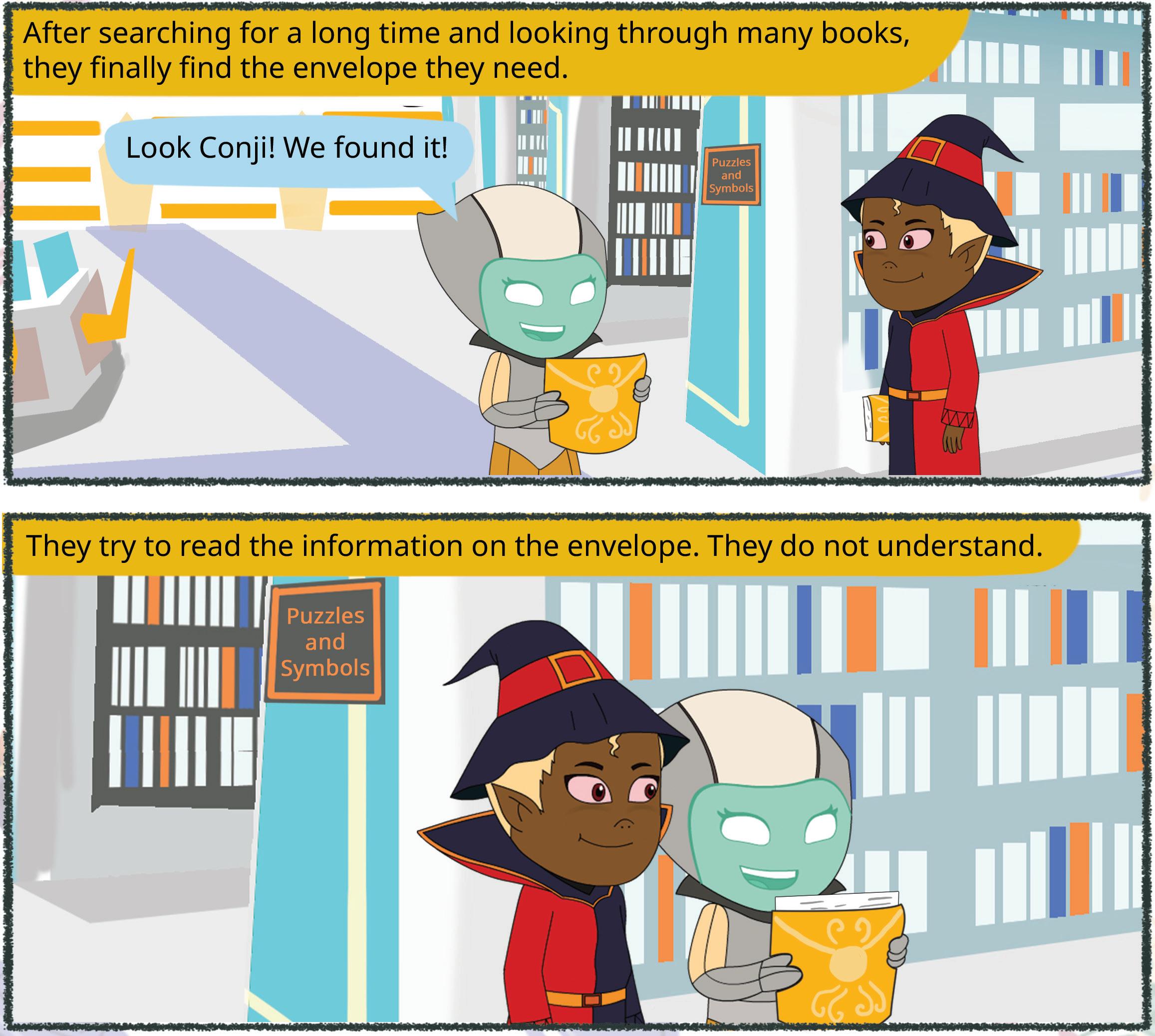


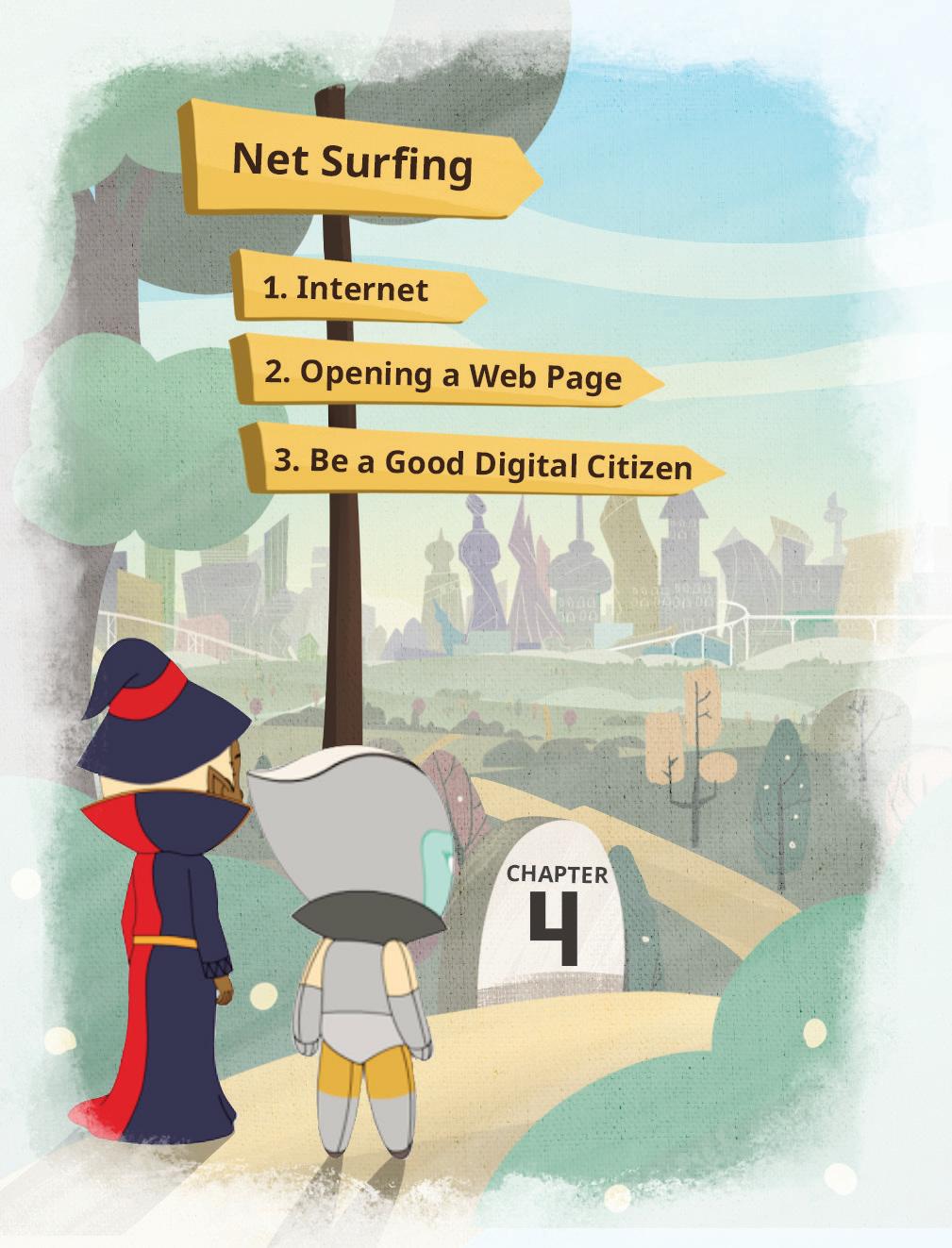



Imagine it is your birthday, and your grandparents live in another country. They can’t visit you, so they surprise you with a video call where they sing a birthday song for you.
What helped you connect the video call with your grandparents?
The internet helped you connect to the video call. Our phone or laptop is connected to the internet, which allows us to video call another person.

Two or more computers connected to each other form a computer network.
The internet is a network that connects computers all over the world. We use the internet to:
1. Share information with others.
2. Learn new things.
3. Be in touch with our family and friends.

What are some other things that you can do on the internet?

The internet is very useful if we use it correctly. Let us learn more about the advantages of the internet:
1. The internet makes tasks quick and easy.
2. The internet helps us talk to faraway friends and family.
3. The internet allows us to learn about new things.
4. The internet allows us to watch films and cartoons, listen to songs, play games, and read books.

5. The internet helps us shop online to buy clothes, toys, books, food, etc.
6. The internet allows us to do money-related tasks, like transfer money, book tickets, etc.

Everything has a good side and a bad side if we do not use it responsibly. Let us learn more about the disadvantages of the internet.
1. There are bad people on the internet who can attack our phones or computers. They can get our personal data or photos if we do not use the internet responsibly.
2. People send unwanted messages or emails over the internet. Many times, these messages can be mean and hurtful.












3. When we spend a lot of time on the internet, it can distract us from our important tasks like homework, exercise, cleaning our room, etc.
4. When we are too involved with the screen while using the internet, it affects our health.
The basic terminologies we should know while using the internet are:
S. No. Basic Terms Description
1. Web page A web page is a simple document that can be displayed over the internet using a browser.
2. Website
Website A website is a collection of web pages that contain information about a related topic.





















3. Web browser



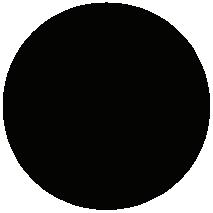



Mozilla Firefox Safari










Google Chrome Opera

Microsoft Edge
4. Search engine
Google Yahoo Bing
5. Email
6. URL



How does the internet work? Scan here to find out!
A web browser allows us to view the information present on websites and web pages. Some popular web browsers include Google Chrome, Mozilla Firefox, Safari, Opera, and Microsoft Edge.


A search engine can search for the information required by the user over the internet. Some of the most popular search engines are Google, Yahoo, Bing, etc.
Email stands for electronic mail. Email is a way to send messages to people over the internet.
All the websites have a web address. A web address helps us open a website in the browser.
This web address is known as URL (Uniform Resource Locator).

Archie was the first search engine, and it was created by Alan Emtage in 1990. Did You Know?

1 Match the following.
Definitions
Two or more computers that are connected to each other.
The network spread across the world.
A collection of web pages.
It helps us view the information present on websites and web pages.
Terms
Internet
Website
Web Browser
Computer Network
2 Read the following sentences. Mark the advantages of computers with A and the disadvantages of computers with D.
a The internet helps us share information with others.
b There are bad people on the internet who try to steal our personal data and pictures.
c People sometimes send mean and hurtful messages or emails over the internet.
d We can talk to faraway friends and family using the internet.
To visit a website or a web page, you need to know its web address, or the URL. Let us say we want to open the web page with the web address “www.uolo.com”.
To open the web page, follow these steps:
1. Open a web browser. Here, we will use Google Chrome.
2. Type “www.uolo.com” in the address bar at the top of the browser window.

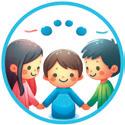
3. Press the Enter key on the keyboard. The website will open. Website

Being a good digital citizen means using the internet carefully. It means being aware of the risks of online activity and taking steps to protect yourself and others.
Follow the rules given below to be a good digital citizen:
1. Treat people with respect over the internet.
URL Address Bar Explore More!
2. Use kind words.
3. Do not write bad things about others.



Do you want to know how we can be safe online? Scan here to find out!
4. Sometimes people say rude things online. This is called cyberbullying. If it happens to you, let your parents or teachers know about it immediately.
5. If you end up opening a wrong website by mistake, close it immediately.

Mark the good online behaviours with G and the bad behaviours with B.
Argue with people online.
Do not share password with others.
Be kind and respectful.
Spend unlimited time on the internet.
1 Two or more computers connected to each other form a computer network.
2 The internet is a network that connects computers all over the world.
3 A web page is a simple document that can be displayed over the internet.
4 A website is a collection of web pages that contain information about a related topic.
5 A web browser allows us to view the information present on websites and web pages.
6 A search engine can search for information over the internet.
7 Email is a way to send messages to people over the internet.
8 A web address, or URL, is required to visit websites using the web browser.
9 We should follow some rules as good digital citizens:
a Be respectful online.
c Do not share passwords.
b Use kind words.
d Limit screen time.
A. Fill in the blanks.
Hints uniform resource locator internet computer network cyberbullying search engine
1 A is a group of two computers connected to each other.
2 URL stands for .
3 is a worldwide network of computers which allows the sharing of information.
4 A can search for information required by the user.
5 If people say rude things online, it is called .
B. Tick () the correct option.
1 Using the internet, we can:
a Video call our relatives
c Shop online
b Send an email
d All of these
2 What are the responsibilities of a good digital citizen?
a Sharing passwords
c Being kind and respectful online
b Arguing with online friends
d Disrespecting people online
3 Which of the following is personal information that you should NOT share online?
a Your favourite colour
c Your favourite game
4 What does U stand for in URL?
a Universal
c Uniform
5 What is an email used for?
a Playing online games
c Online shopping
b Your house address
d Your favourite food
b Unique
d Unusual
b Sending electronic message
d Clicking pictures

C. Who am I?
1 I am a type of network that helps us talk to faraway friends and family using video calls.
2 I am a place in the web browser where you type a URL.
3 I am a type of address that helps open a website.
4 I am a good person who takes steps to protect myself and others.
5 I am the act of saying rude things over the internet.
D. Write T for True and F for False.
1 The internet helps us shop online to buy clothes, toys, books, etc.
2 Google is a search engine.
3 Email is a way to call other people over the internet.
4 Microsoft Edge is a web browser.
5 You should tell your parents if someone bullies you online.
E. Answer the following questions.
1 Why do we use email?
2 Write the names of any two popular search engines.
3 What happens when we spend a lot of time on the internet?
5 What should you do if you end up opening a wrong website by mistake?
F. Apply your learning.
1 Chirag is playing online games with friends on a website. What helped him play games online?
2 Sandhya shared her school’s name with a stranger over the internet. Was it a good thing to do? Give your reason.
3 Sree wants to look up information for a school project. What can help her find the information?
4 Sheetal wants to know about space and planets. She found the web addresses of a few websites. What should she use to open the websites?
5 Simran is using the internet the whole day. What should you suggest to her?







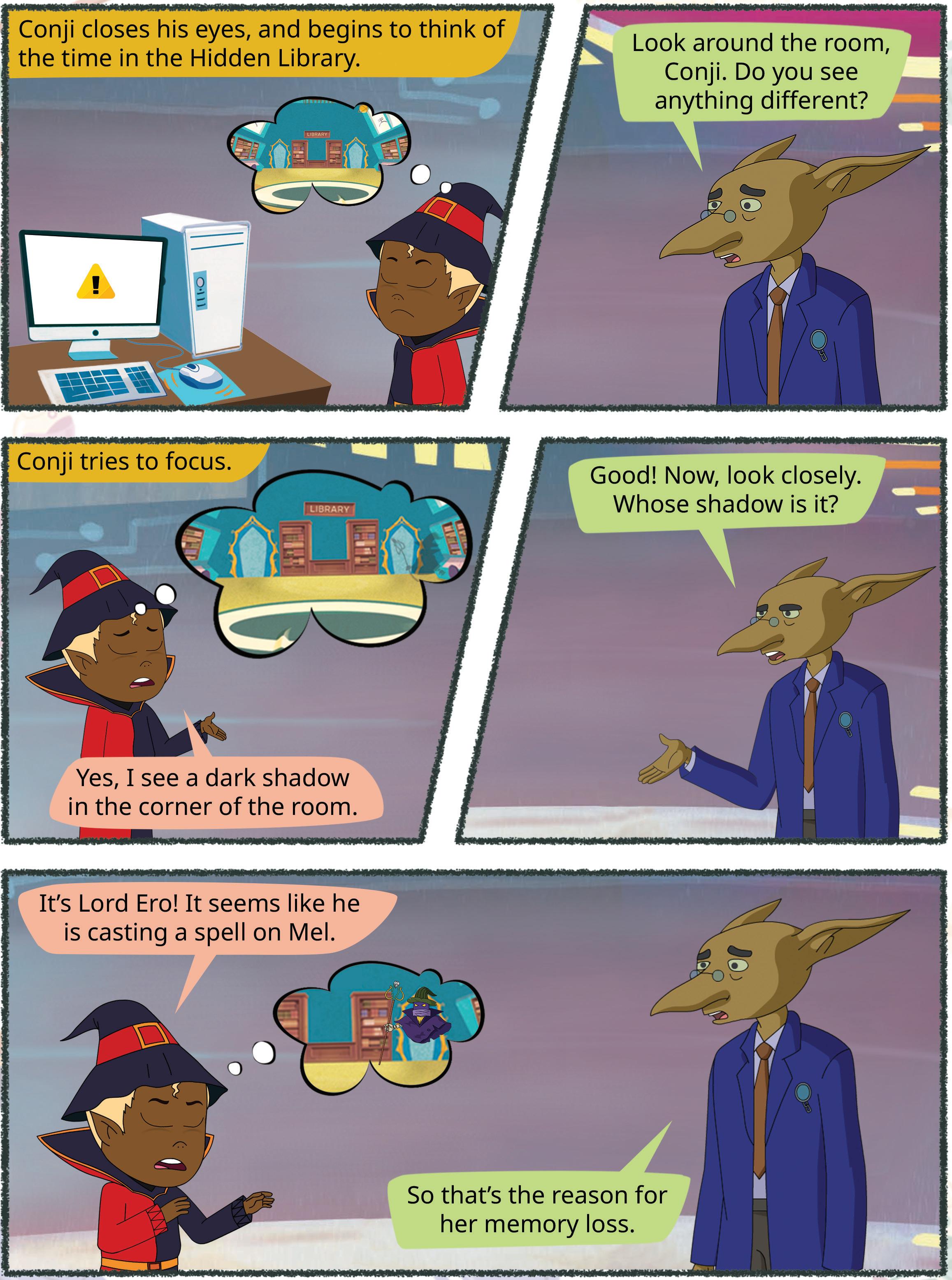


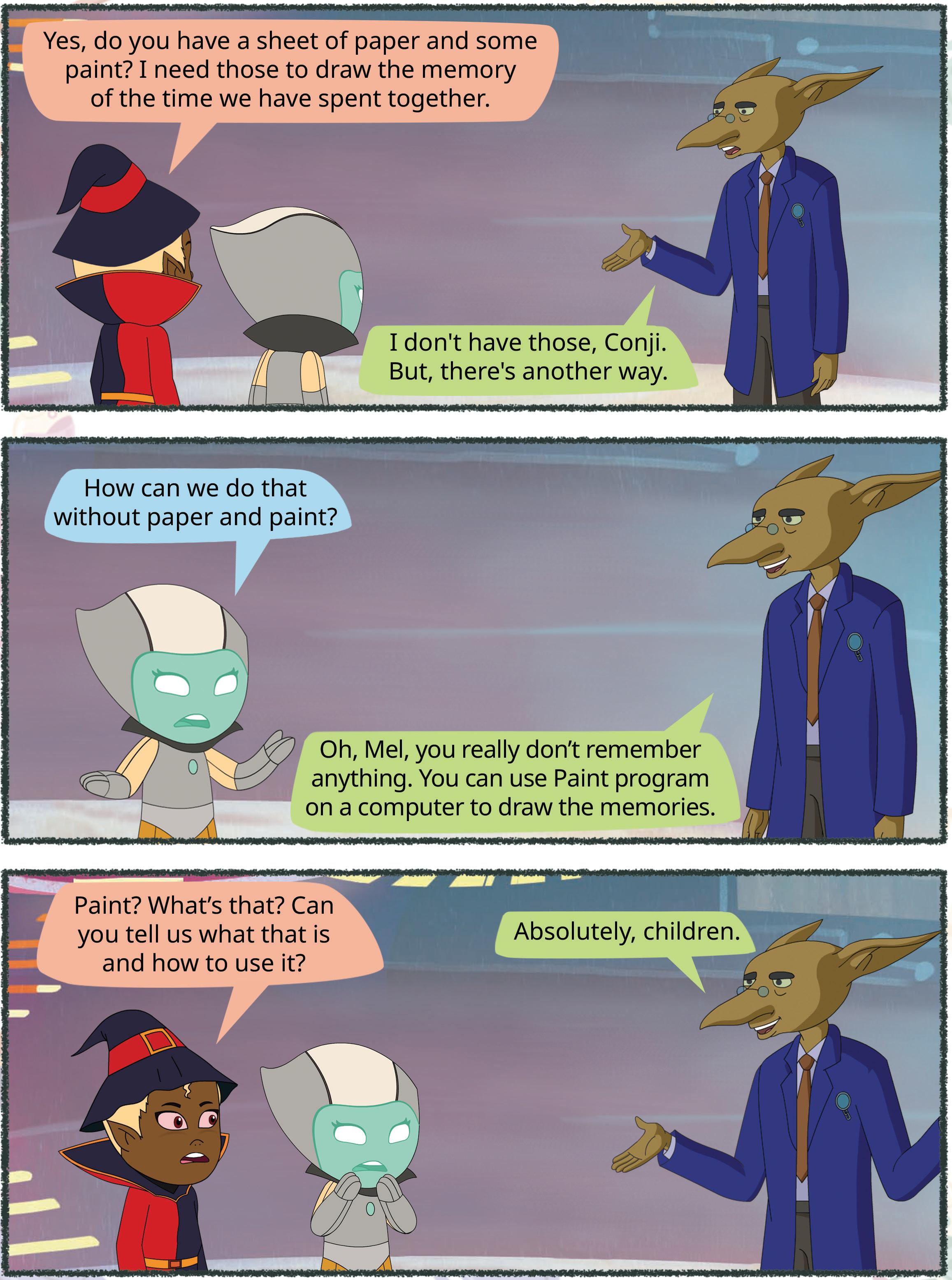




The lotus is the national flower of India. It is a beautiful flower that grows in ponds and lakes. It symbolises purity and strength.
Let us colour this picture of lotus.
Just like you draw and colour beautiful things around you on paper, you can also draw these things on a computer, using a program called MS Paint.
MS Paint, a short form for Microsoft Paint, is like a colouring book on the computer, where you can draw and colour pictures using different tools and colours.
It allows users to create and edit simple drawings, digital art, and images using various tools like brushes, shapes, and colour palettes.

Dan McCabe created this colouring book on the computer called MS Paint.

Let us learn how to open Paint on the computer.
1. Click on the Search bar.
Type here to search

2. Type paint.
3. Click on the Paint app.
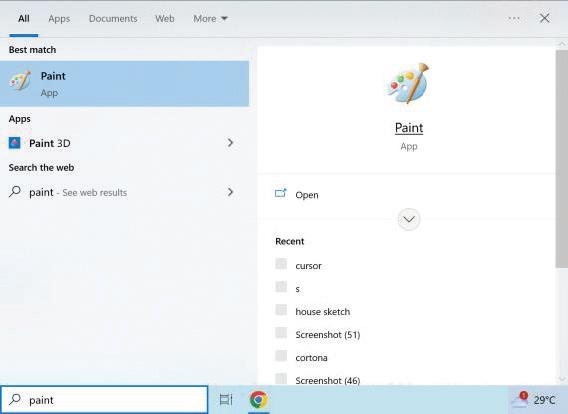
4. After clicking, the Paint window will open, as shown in the image.
Let us learn about the components of the Paint window that help you create paintings.
1. Title Bar: It shows the name of your drawing.
2. File Tab: It has options for creating a drawing, saving a drawing, opening a drawing, and more.
3. Quick Access Toolbar: It is a group of tools that helps to perform common tasks like saving a drawing.
4. Drawing Area: It is the space where you create drawings.
5. Ribbon: This has two tabs: Home and View. Each tab has many tools that are arranged into different groups. A group is a set of related commands.

Complete the words.
Let us create a comic strip between two characters, the sun and a flower, using various shapes to tell a story in a fun way.
The Shapes group help us draw different types of shapes in our paintings, like circles, squares, lines, etc.
Here, we will use some shapes like rectangles, circles, and squares to create a comic strip. All shapes are present in the Shapes group of the Home tab.


Steps to use the Shapes group to draw a comic strip:
1. Open Paint.
2. Click on the Rectangle from the Shapes group.
3. Drag the mouse pointer on the drawing area to draw a rectangle.


4. Click on the Oval in the Shapes group.
5. Drag the mouse pointer on the Drawing area and draw a circle, as shown in the image below.
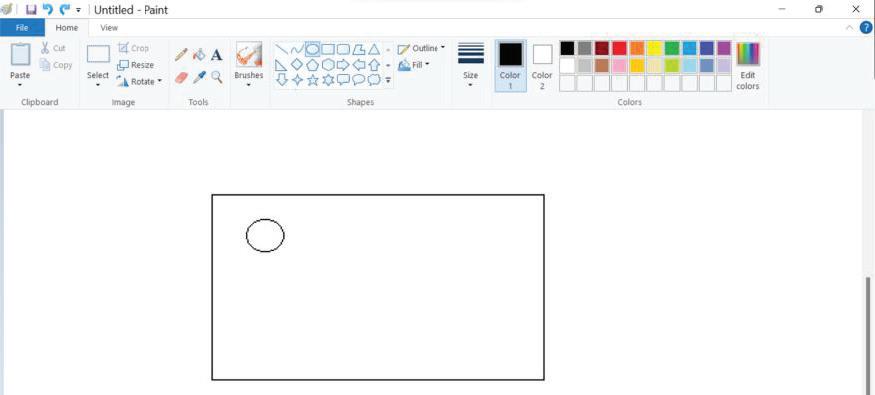
6. Click on the Six-point star shape in the Shapes group.
7. Draw a star over the circle shape so that it looks like sun rays.
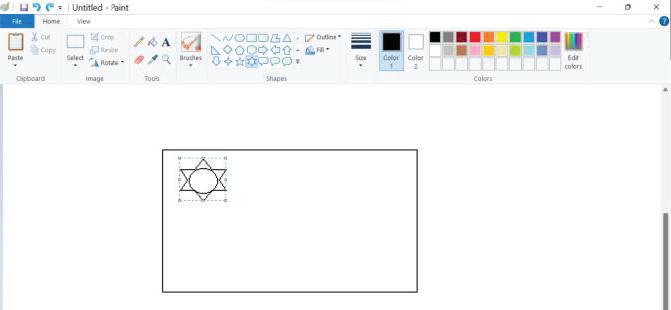
8. Draw a square using the Rectangle shape. Hold down the shift key while dragging out a rectangle.
9. Click on the Rounded rectangle shape.
10. Draw a rounded rectangle at the top of the square drawn so that it looks like a flower pot.

A callout is a shape that is used to write a message. Let us write some messages in the callouts.

There are three types of callouts: Rounded rectangular callout, Oval callout, and Cloud callout. They are also present in the Shapes group.
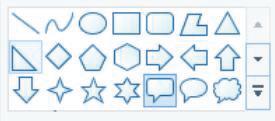

Cloud callout
callout
Rounded rectangular callout
Let us add a message box on the comic strip using callouts.
Steps to add a callout:
1. Click on the Rounded rectangular callout from the Shapes group.

2. Drag it over the area where you want to draw a callout.
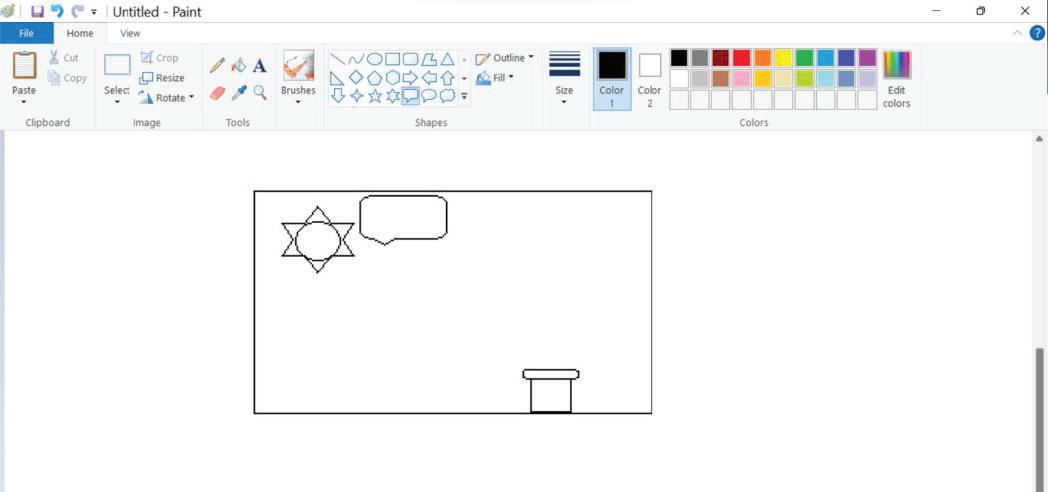
Let us learn about some more tools in MS Paint.
We already drew the sun and a flower pot. Now, let us draw the stem and leaves of the flower in our comic strip with the help of the Pencil tool.
The Pencil tool is used to draw freehand drawings in Paint.
The Pencil tool is present in the Tools group of the Home tab. Let us learn how to use the Pencil tool in Paint.
Steps to use the Pencil tool:
1. Click on the Pencil tool in the Tools group.
Pencil

2. Select any colour from the Colors group.


3. Move the Pencil to the drawing area.
4. Start drawing the stem and leaves by dragging the mouse.

As we have completed our drawing, let us now learn how to add text to a callout.
You added a callout in the comic strip. Now, you want to write some text in the message box. You can do this with the help of the Text tool present in the Tools group.
The Text tool helps us add text to our drawing.
Steps to add text:
1. Click on the Text tool in the Tools group.

2. Click in the callout where you want to add the text.
3. Type your message. For example: “Good Morning, Rosie! You look taller today. How?”
Good Morning, Rosie! You look taller today. How?
Think and Tell
Can we add text in the blank drawing area?

While drawing, you sometimes make mistakes that you want to erase. You can do it with the help of the Eraser tool present in the Tools group. The Eraser tool helps us erase a mistake.
Steps to use the Eraser tool:
1. Click on the Eraser tool from the Tools group.

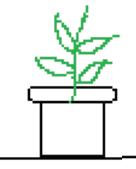

Before Erasing After Erasing

2. Drag it on to the part of your drawing which you want to erase.

Do you want to know how we can change the colour of the eraser in Paint? Scan here to find out!
The Brushes group provides various brush tools for freehand drawing and painting in Paint. Brushes help us apply various strokes and effects on the drawing area.
There are 9 types of brushes in Paint. A few examples of brushes are Airbrush, Crayon, Marker, Natural pencil, and Oil brush.
Airbrush Tool

Now, we want to draw a petal in the flower pot using the Airbrush tool.
An Airbrush is a tool that gives the effect of spray paint. It is used for spraying and drawing with the colours.
Steps to use the Airbrush:
Brushes
1. Click on the Brushes tool.

2. Select Airbrush from the list of brushes.


3. Drag it where you want to paint.



You can also colour your drawing. Let us see how we can do it.
4. Add a message for the flower in the callout, following the same steps as you did for the sun.
Good Morning, Mr Sun! Your warm rays fill me with happiness!

To change the brush size, hold down the Ctrl key and press the plus (+) or minus (–) keys on your keyboard. Did You Know?

After drawing the sun and the flower and adding text to the callouts, you can fill the drawing with colours to make it look beautiful. You can use the Fill with color tool present in the Tools group for this purpose.
The Fill with color tool is used to fill colours in your drawing.
Steps to use the Fill with color tool:
1. Click on the Fill with color tool in the Tools group.
2. Choose any colour from the Colors group.

Fill with color

3. Bring the pointer inside the petal of your flower and click. The colour will be filled inside the petals.
4. Also, fill the leaves and flower pot with colour.


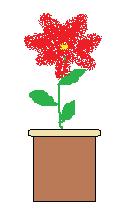
We can choose more colours from the Edit colors icon in the Colors group. Did You Know?

The Color picker tool is used to select colours from existing drawings and fill other parts of the drawing with the same colour.
Steps to use the Color picker tool:
1. Click on the Color picker tool in the Tools group.
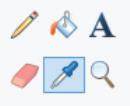
Color picker
2. Click on the drawing from which you want to pick the colour. For example, click on the surface of the flower pot.


Good Morning, Rosie! You look taller today. How? Good Morning, Mr Sun! Your warm rays fill me with happiness!
3. Click in the area where you want to fill the picked up colour. Here, we have filled the picked up colour in the background.
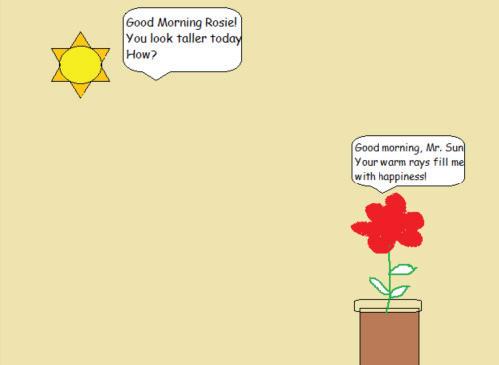

Good Morning, Rosie! You look taller today. How? Good Morning, Mr Sun! Your warm rays fill me with happiness!

Do you want to create a custom brush in Paint? Scan here to find out!

1 What are the names of the tools in the images?



2 Match the following.




1 MS Paint is like a colouring book on the computer.
2 Paint consists of different components, such as the Title bar, File Tab, Quick access Toolbar, Ribbon, and Drawing Area.
3 Rectangle, Circle, Rounded Rectangle, etc., are different types of shapes in the Shapes group.
4 The Pencil tool in Paint is used to draw freehand drawings.
5 Text tool helps you add text to your drawing.
6 Brushes provide various brush tools for freehand drawing and painting in Paint.
7 The Fill with color tool is used to fill colours in your drawing.
8 Color picker tool is used for picking a colour from the existing drawings and filling other parts of the drawing with the same colour.
A. Fill in the blanks.
1 The space where you create drawings in Paint is called the .
2 Rectangle, Circle, Rounded Rectangle are different types of .
3 To add text to a callout in Paint, you can use the tool.
4 The Eraser tool is used to mistakes in your drawings.
5 The Fill with color tool is used to fill in your drawing.
B. Tick () the correct option.
1 Paint is a tool for:
a Searching
b Recording voice
c Drawing d Sending message
2 Which one of the following tools in Paint will you use to draw a flower?
a Pencil b Rectangle
c Eraser
d Text
3 Which one of the following tools in Paint is used for spraying and drawing with colours?
a Pencil
b Star
c Airbrush d Eraser
4 Which one of the following tools is used to select colours from existing drawings and fill other parts of the drawing with the same colour?
a Color picker
c Fill with color
5 What can you create with Paint?
a Mountains
c Digital arts
b Pencil
d Eraser
b Flowers
d All of these

C. Who am I?
1 I am a set of related commands in the Paint window.
2 I am the part of the Paint window that shows the name of your drawing.
3 I am a shape used to write messages in a drawing.
4 I am used to fill colours in your drawings to make them look beautiful.
5 I am a group in Paint that contains 9 types of brushes.
D. Write T for True and F for False.
1 MS Paint stands for Microsoft Paint.
2 The Quick Access Toolbar of Paint shows your drawing.
3 The Pencil is a tool in Paint that can be used to draw lines, circles, and curves.
4 The Brushes tool in Paint helps us correct mistakes in our drawings.
5 The Color picker tool is used to select colours from the Colors group.
E. Answer the following questions.
1 What is Paint?
2 Write the names of the three types of callouts present in Paint.
3 What is the use of Brushes in Paint?
4 Define the Quick Access
5 How are shapes useful in Paint?
F. Apply your learning.
1 Riya wants to draw stars and the moon on her computer. Which program can help her do that?
2 Sakshi made a mistake while drawing in Paint. What tool should she use to resolve her problem?
3 Rinku wants to choose a colour from her existing drawing and use it to fill another part of her drawing. Which tool should she use?
4 Archi wants to write "Home Sweet Home" on the drawing of a house she drew. Which tool will help her write text in the drawing?
5 Atul wants to create a pattern of circles on his Paint canvas. Which tool will help him create the shape?





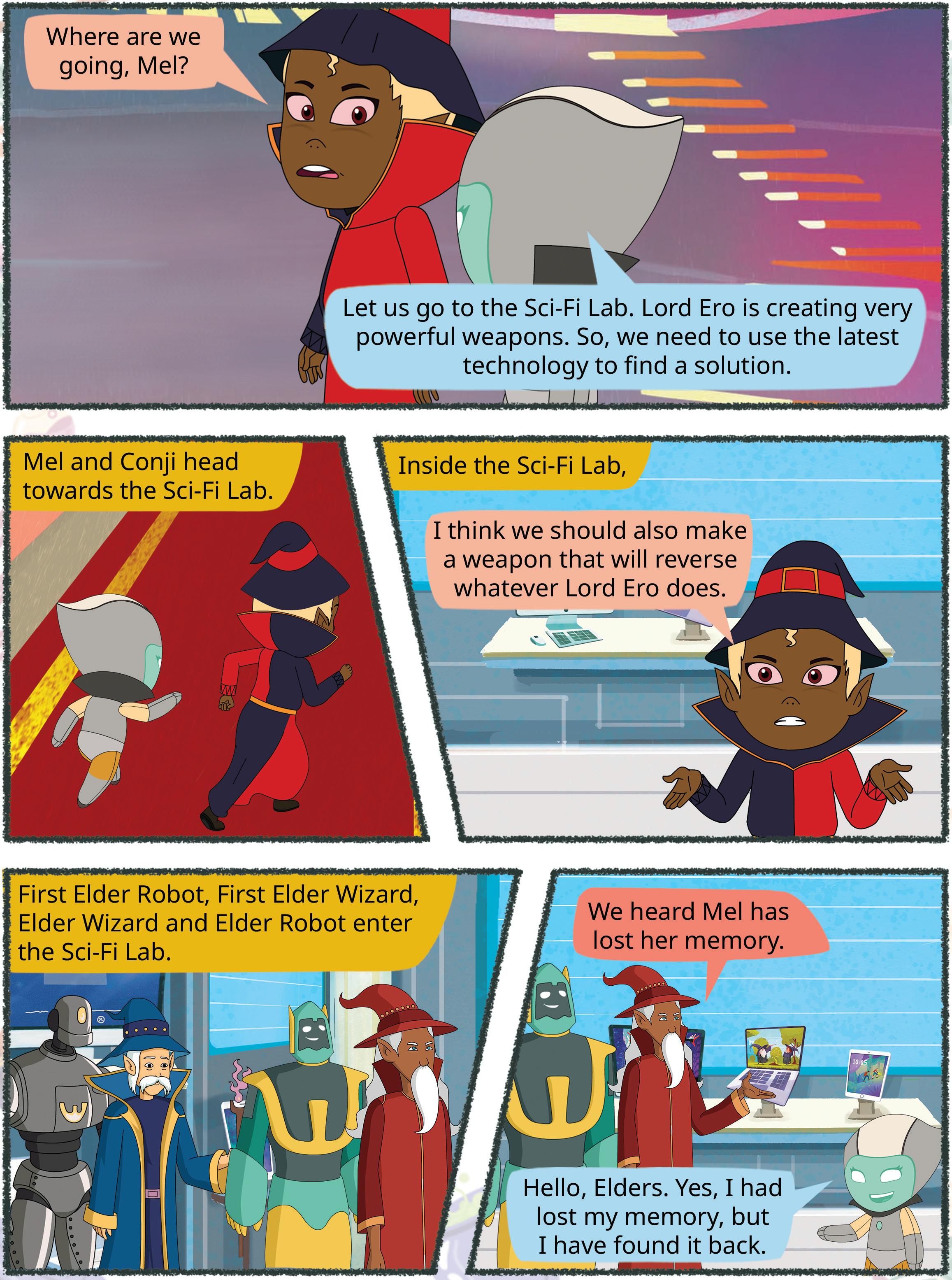




All of you do your homework in your notebooks, correct?
So far, you have been writing your homework in your notebooks. But if you have to do it on a computer, how will you do it?
You will use a word processor.
A word processor is a software program that allows you to create, edit, and format text documents.
While using a computer to do your homework, you write in documents. Like a notebook, a document can also have multiple pages.
So each document is like your notebook, where you can write text, draw images, etc.
There are many word processors, like Microsoft Word, WordPerfect, Google Docs, etc.
In this chapter, you will learn about the basics of Google Docs.



Google Docs is a free online word processor. All you need to have is an internet connection to be able to use Google Docs anywhere and anytime. In Google Docs, you can also share your documents with other people. When you share a document, multiple people can work on it in real time.
Google Docs has some special features that make it really useful:
1. It allows us to type words, sentences, and stories in a document.
2. It allows us to change the font, colour, and size of text.
3. It allows us to add pictures to make our stories come to life.
4. It allows us to share our stories with friends and work on them together.
5. It automatically saves our work, so we don’t have to worry about losing it.

What are the different things that you can add in your documents?

Before you can write anything in a document, you need to create it. To create a document on Google Docs, you need a web browser. After opening the web browser, follow the steps given below:
1. Type docs.google.com in the address bar of the web browser and press the Enter key.

2. Click on the Blank icon under Start a new document. It will open a blank document with an Untitled document name.
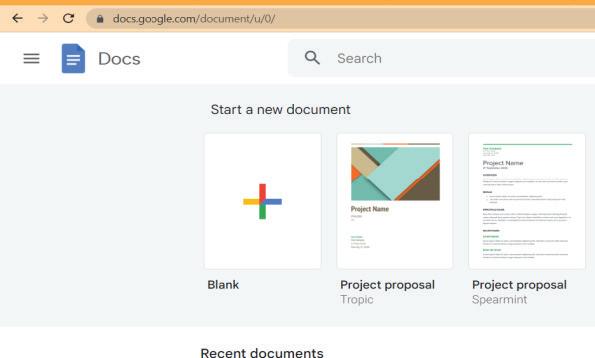

Before using Google Docs, we first have to understand the components of Google Docs.
The image below highlights the various components of the Google Docs window:


1 Document Title It is a name for the document that uniquely identifies the document.
2 Menu Bar It holds “File”, “Edit”, “View”, and other menus. Each menu performs a different action.
3 Quick Access Toolbar The bar that holds tools for quick and easy access.
4 Document Workspace The area where you type.
5 Share It helps you share the document with others.
In Google Docs, you can see the changes made by other people from different computers when working together on a document. Did You Know?

Once the document is created, you have to give it a meaningful name to identify it. By default, the name of the document is Untitled document. The steps to name a document are as follows:
1. Click on the Untitled document written on the top left corner of the document.
2. Press the Delete key and type the new name for the document in it.


Our empty document on Gender Equality is ready. Now, let us add text to it.
A Google Docs document can contain up to 1.02 million characters. Did You Know?


After giving a name to the document, it is time to type text into it.
Let us write a paragraph on the topic: Gender Equality
1. Click on the page to place the cursor.
2. Type Gender Equality.
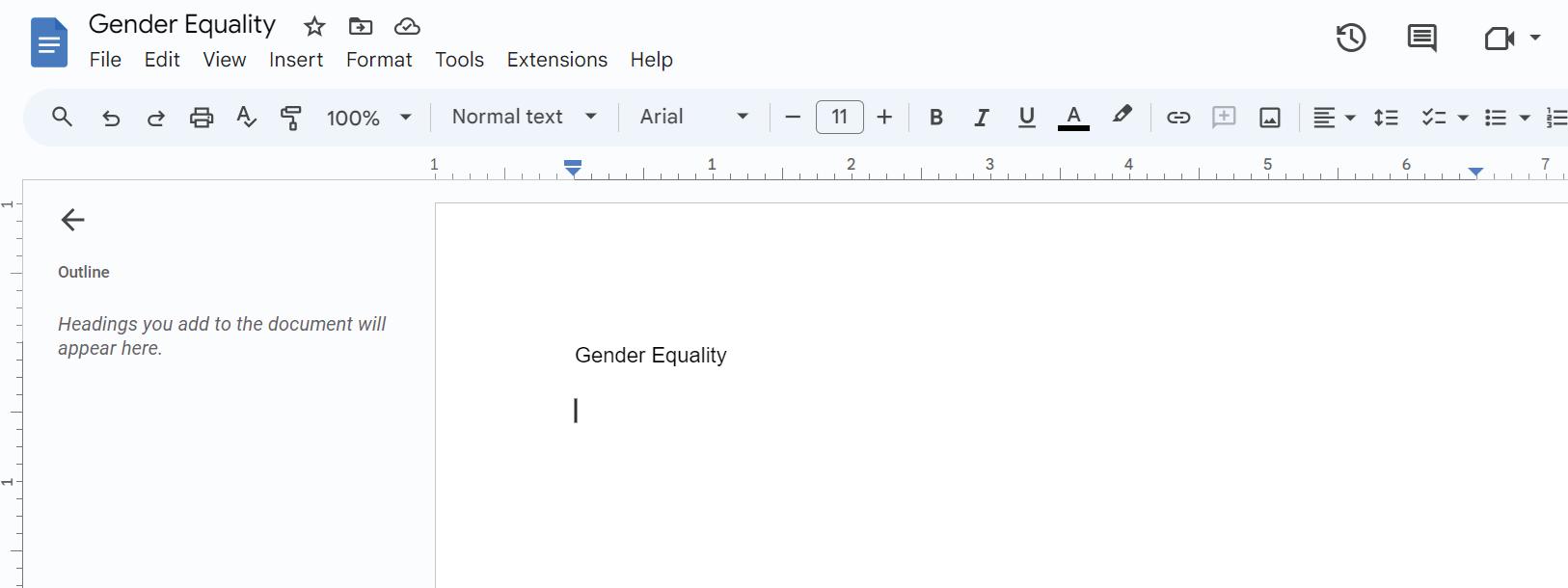
3. Press the Enter key to go to the next line.
4. Type the next text that you want to type. In our case, we have typed the following text:






When you are done with writing the document, it is important to save the work on your computer. But in Google Docs, you do not need to keep track of saving your file because it has the Autosave feature with it.
Autosave is a feature of Google Docs that automatically saves an open document or file.
Let us see how Autosave works in Google Docs.
1. Look at the Saving option (as shown in the picture) on the top of your document, it shows that Google is saving your file.
2. Once Google saves your document, a picture of the cloud (as shown in the picture) appears. This shows that your document is saved.
3. Once your document is saved, you can close this document by clicking ‘X’ on the tab. This button is the Close button.



Think and Tell
Do you think Autosave will work if your computer is not connected to the internet?
1 Unscramble the following words.

a asve b mane c Ordw d eilf e shrae
2 Circle the odd word.
a word chair table almirah
b mouse Google keyboard monitor
c pen pencil docs crayon
d word document file pencil
e save close share air
If you have closed the document but want to work on the same document again, follow these steps:
1. Type “docs.google.com” in the address bar of the web browser. This will take you to the Google Docs screen.
2. You may find your document in Recent documents.

3. If you do not find your document there, type the name of the document in the Search bar.

4. It will show you the document. Click on it to open.

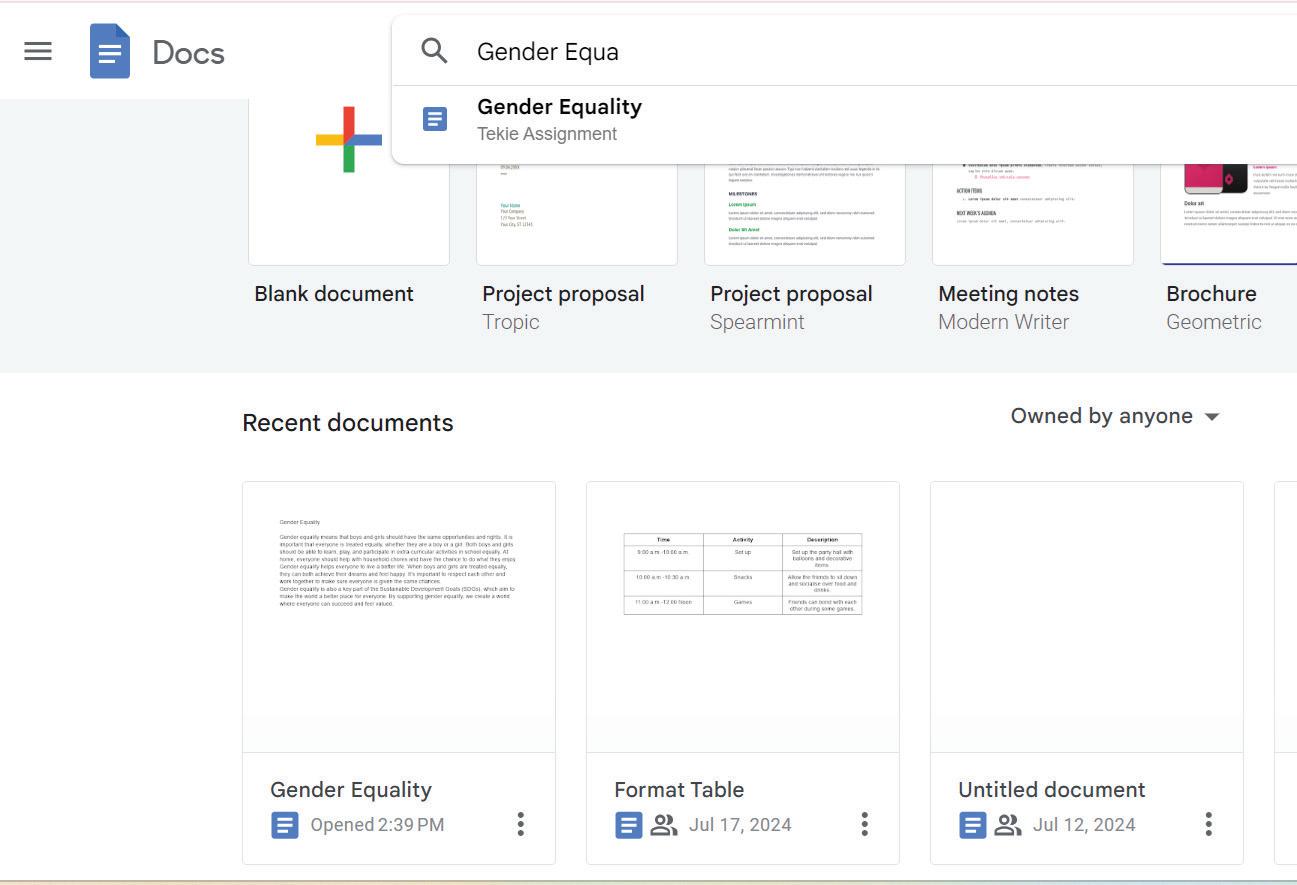
Discuss three features which you can apply to your documents if you are working on Google Docs.


Sometimes, you might need to open a document while you are already working on another one.
Here are the steps to do that:
1. Click on the File menu.
2. Select the Open option.
3. Click on the document which you want to open.
4. Click on the Open button.
5. The selected document will open in a new tab.
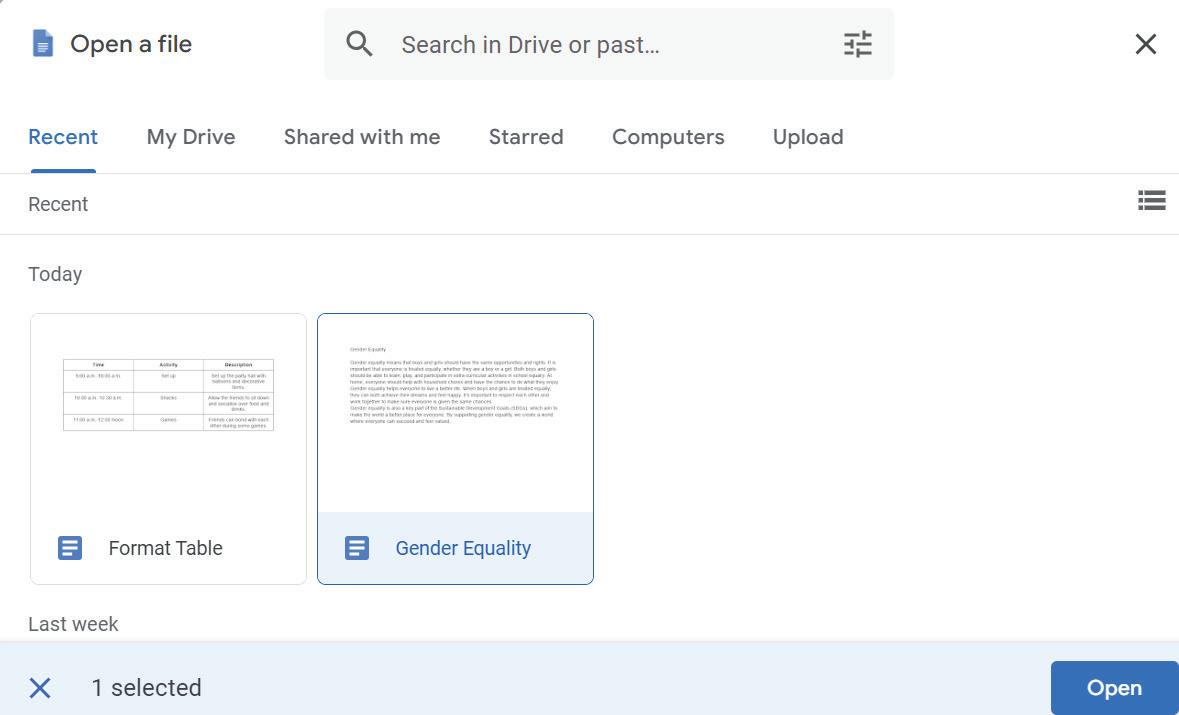





2 Match the columns.
Column A Column B
Google Chrome Docs
Autosave Blank document Saved




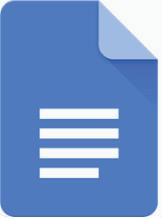
1 A word processor is a software program that allows you to create, edit, and format text documents.
2 Google Docs is a free online word processor.
3 In Google Docs, you can also share your documents with other people.
4 By default, the name of the document is Untitled document.
5 Autosave is a feature of Google Docs that automatically saves an open document or file.
6 You can open an already existing document in Google Docs by clicking on File > Open option.
A. Fill in the blanks.
Hints autosave uniquely word processor quick access edit
1 Word processor is a computer program that helps you to create and a document.
2 Google Docs is a .
3 feature saves the document automatically.

4 The name of the document helps you identify the document .
5 tool bar holds tools for quick and easy access.
B. Tick () the correct option.
1 Which of the following is a feature of Google Docs?
a Can type stories
c Can share stories
b Can edit stories
d All of these
2 The symbol of the cloud with a tick mark shows that the:
a Document is saved
c Document is lost
3 In a document tab, ‘X’ sign is used to:
a Save the document
c Close the document
4 ‘Share’ option will help you:
a Share the document with friends
c Copy the document

b Document is closed
d Document is shared
b Open the document
d Share the document
b Save the document
d Move the document
5 Which of the following is a step to open a closed document?
a Click on the File Menu > Click on the New Option
b Click on the File Menu > Click on the Open Option
c Click on the File Menu > Click on Docs
d Click on the File Menu > Click on the Share option
C. Who am I?
1 I am a bar to search for your document if you can’t find it in your recent documents.
2 I hold menus like “File”, “Edit”, “View”, etc.
3 I am a button in Google Docs that you click to save your document.
4 I will help you to show your document to your friend even if you are not together.
5 I am a place where you can type words into your document.
D. Write T for True and F for False.
1 Google Docs is a paid online word processor.
2 By default, the name of the document is Untitled document.
3 To save a document in Google Docs, the step is File > Save.
4 To close a document in Google Docs, the step is File > Close.
5 The file must be opened before you start writing in it.
E. Answer the following questions.
1 Write any two features of Google Docs.
2 What does autosave mean?
3 Write down the steps to open a new document.
4 What will happen if you do not save your document?
5 How can you close a document?

F. Apply your learning.
1 Ram has created many documents in Google Docs, but he is unable to find them. What should he do?
2 Amit is working on a document in Google Docs and is worried about losing it. How can he save it?
3 Ritu wants to begin working on a new document. What should be her first step?
4 Raju wants to uniquely identify his document. What should he do?
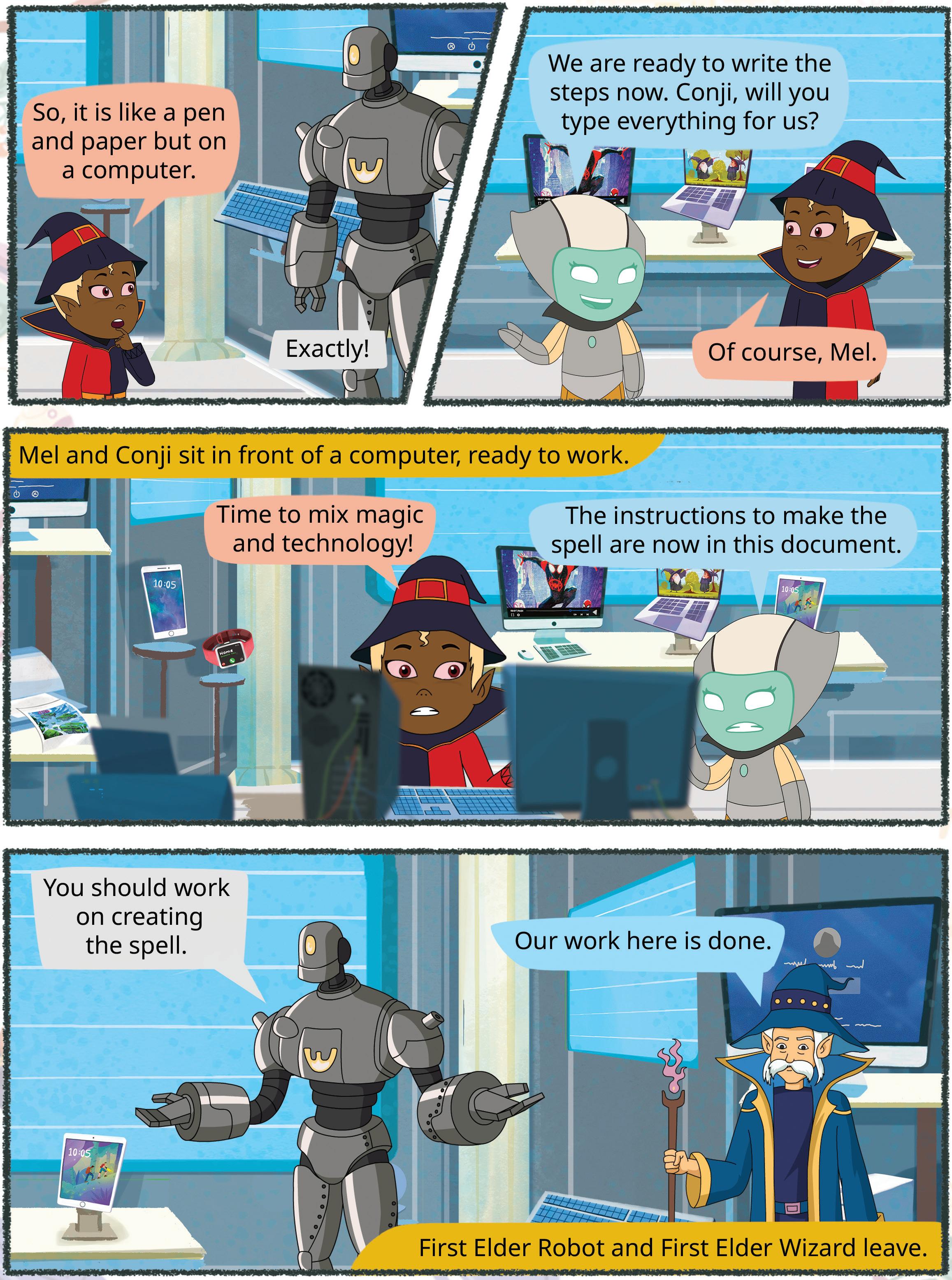

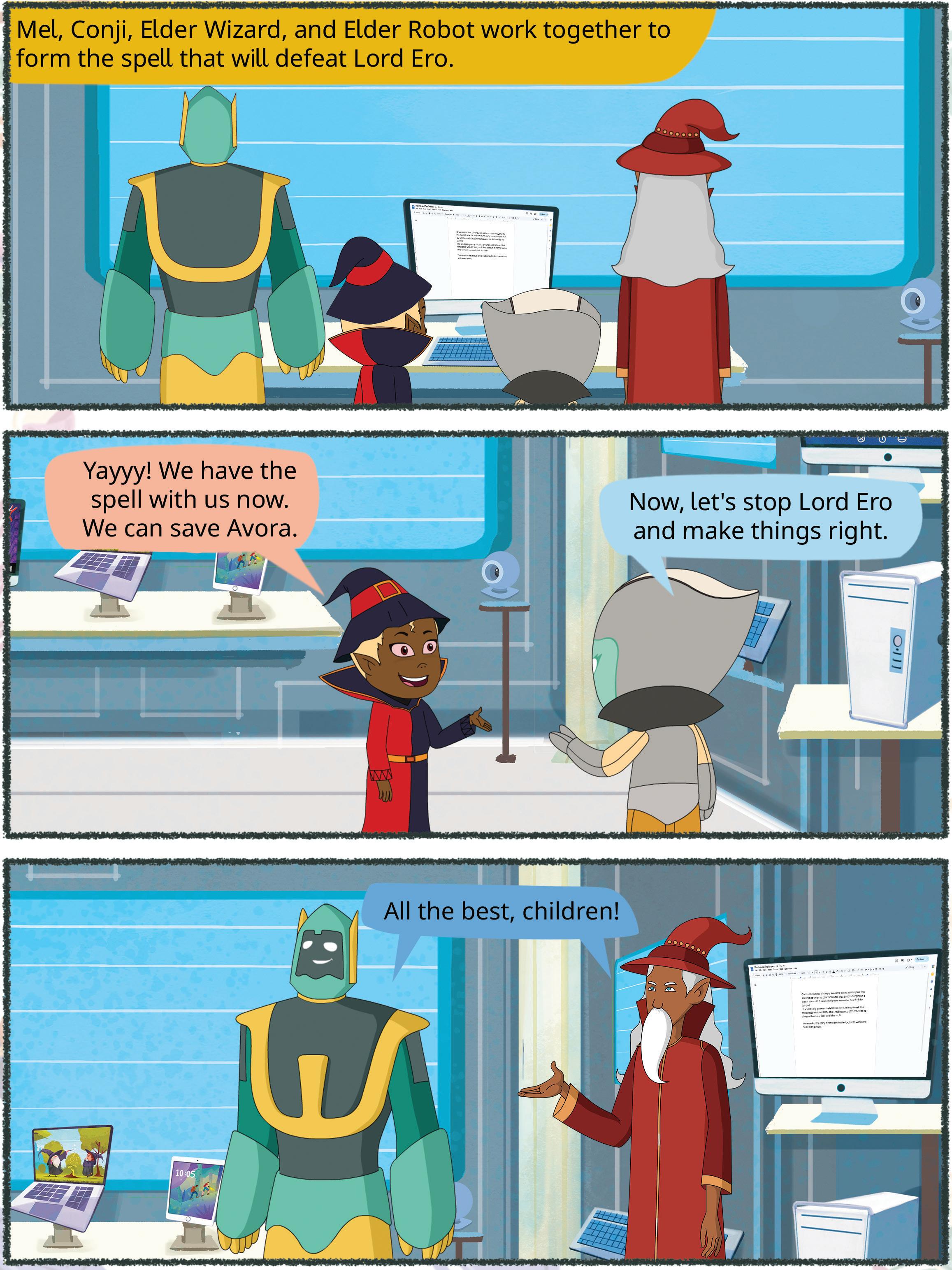
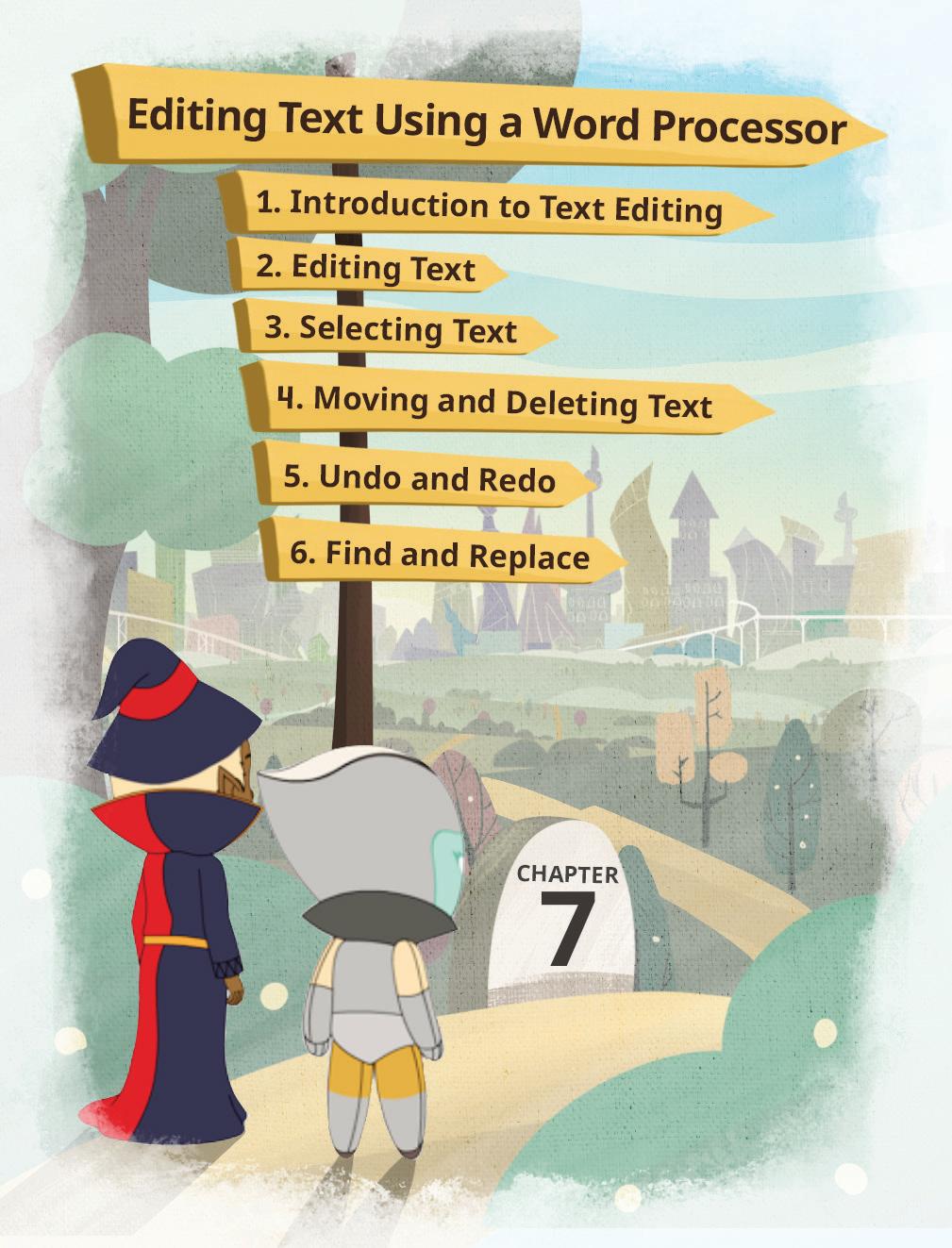






In the previous chapter, you created a document on gender equality. You also learnt how to create, save, search, open, and share a document. In this chapter, you will learn how to edit text in documents.
Text editing in Google Docs is the process of making changes to the text to improve its clarity and accuracy. It can also include copying, deleting, and moving the text.
Once you type the text in any document, you may want to make some changes to that text. For example, if you want to add some text about the topic, ‘Challenges to Gender Equality’ in the ‘Gender Equality’ document, you can do it by following the steps given below:
1. Place your cursor where you want to add the text. Press the Enter key.

2. Enter the name of the topic. In our case, it is ‘Challenges to Gender Equality’. After writing it, press the Enter key.
3. Type the text that you want to enter.

After typing the text, you can perform many operations on it, like deleting the text, duplicating the text, etc. For this, you need to first select the text. You can select a letter, a word, a block of text, a paragraph, or the complete document.
Selecting text using a mouse:
1. A word: Double-click on the word.
2. A paragraph: Triple-click anywhere on the paragraph.
3. A block of text: Click at the beginning of the text, drag over it, and then release the mouse button.
4. Complete document: Click on the Edit menu and choose the Select all option.
Selecting text using a keyboard:
1. A character to the left of the cursor: Press the Shift + Left Arrow keys.
2. A character to the right of the cursor: Press the Shift + Right Arrow keys.
3. A word to the left of the cursor: Press the Ctrl + Shift + Left Arrow keys.
4. A word to the right of the cursor: Press the Ctrl + Shift + Right Arrow keys.

5. A line to the left of the cursor: Press the Shift + Home keys.
6. A line to the right of the cursor: Press the Shift + End keys.
7. A paragraph up to the cursor: Press the Ctrl + Shift + Up Arrow keys.
8. A paragraph below to the cursor: Press the Ctrl + Shift + Down Arrow keys.

9. Complete document: Press the Ctrl + A keys.
How can you select the complete document using the mouse? Scan here to find out!
If you have a word that you want to use many times in your document, then instead of typing it again and again, you can just copy and paste it wherever you need it.
In this way, you save time and do not have to keep typing the same word over and over.

Copying text means duplicating the selected text and making it available for another location.
Pasting means putting something you copied from one place into another in the same document or another document.
Suppose you want to continue typing, and you have to start the paragraph with ‘Gender equality.’ Instead of typing it again, you can just copy it from the top part of the document and paste it at the point where you have to type it again.
You can copy the text with a keyboard or a mouse. Using the keyboard, press the Ctrl and C keys together. The steps to copy the text using a mouse are given below:
1. Select the text that you want to copy. 1 Copied text

2. Click on the Edit menu from the menu bar.
3. Select the Copy option. The selected text is copied.
You can paste the text with a keyboard or a mouse. Using the keyboard, press the Ctrl and V keys together. The steps to paste the text using a mouse are given below:

1. Place the cursor at the location where you want to paste the selected text.

2. Click on the Edit menu.
3. Select the Paste option.
You can see that the text is pasted.
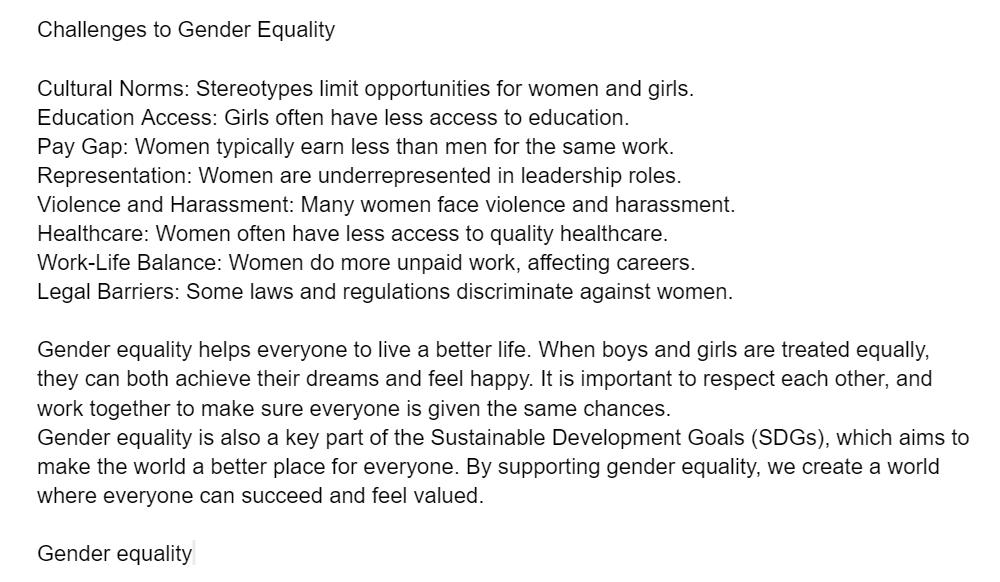
Pasted text


Two or three keyboard keys pressed together are known as shortcut keys. Did You Know?





1 Find the functions of text editing from the given word puzzle.
C O P Y
S L A R
C T S B
D F T E
Q M E N
2 Rearrange the following steps of copy and paste by writing the correct numbers in the given boxes.
Click on the Copy option.
Select the word that you want to copy.
Click on the Paste option.
Place your cursor where you want to add that word.
While editing text, you might realise that some text is in the wrong place and needs to be moved elsewhere.
Moving text means removing it from its original position and placing it at some other position in the document.
We can move text using the Cut and Paste commands. The Cut command removes the text from its original position.
Let us see how we can move the text.
In the above document, for example, you want to change the position of a paragraph from its original position and place it before ‘Challenges to Gender Equality’. Steps to move the text are given below:
1. Triple-click on the first line of the paragraph you want to move to select the complete paragraph.

2. Click on the Edit menu.
3. Select the Cut option or press the Ctrl and X keys together.

4. Place the cursor where you want to paste the text and click on the Edit menu.
5. Select the Paste option.


Think and Tell
Do you think changing the text colour is also a part of text editing?

If, in your document, you write something by mistake that you want to remove, then the Delete key is used.
The Delete key is used to erase a word, line, or paragraph that you want to remove from your document.
For example, in our document, we want to delete the word ‘Gender Equality’ from the end of the document. To do that, we will follow the steps below:
1. Select the text.

2. Press the Delete key. It will erase the selected text. You can also delete the text using the Backspace key.
3. Type the new word if needed.



How can you replace text without deleting the original text?

If you do something wrong in your document by mistake, Undo can reverse the change.
Undo is the command which can reverse the last action.
For example, you have mistakenly deleted the text ‘Gender equality’ in your document, but you didn’t like it, so you want to change it back to the original one.
Undo can be done in three different ways:

Click on the Undo button from the Toolbar. or
Click on Edit menu and then select the Undo option. or Press the Ctrl + Z keys together.

Redo will reverse the last action of the Undo command.
If you need to reverse the action of the Undo command, it can be done by the Redo command.
You will see that the text will be deleted again.
Redo can be done in three different ways:

Click on the Redo button from the Toolbar. or
Click on the Edit menu and then select the Redo option. or
Press the Ctrl + Y keys together.



Do you want to know how we can copy text from one document and paste it into another? Scan here to find out!
Find means to look for a piece of text or a word and discover where it is. Replace means to remove the old text and add a new text in its place.

Steps to find and replace words in Google Docs:
1. Open Google Docs.
2. Click on Edit in the menu bar.
3. Select Find and replace. The Find and replace dialog box will appear.
4. In the Find box, enter the word you want to find.
5. In the Replace with box, enter the word you want to replace it with.
6. Click Next to locate the first instance of the word.
7. Click on the Replace button. The selected text will be replaced.

8. If you want to replace all instances of the word, click Replace all
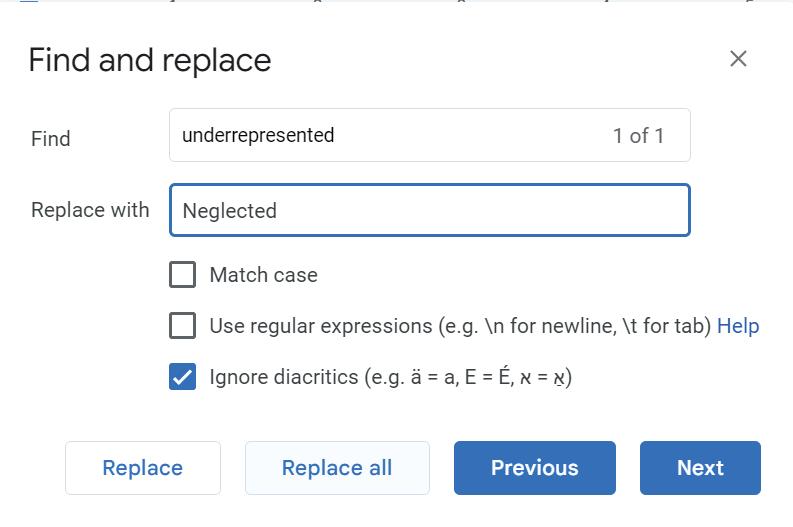
Do It Yourself 7B


1 Text editing in Google Docs is the process of making changes to a text to improve its clarity and accuracy.
2 Editing a text can also include copying, deleting, and moving the text.
3 You can select the text by using a mouse as well as a keyboard.
4 Using the Copy command will keep the original text in its place.
5 You can place the copied text anywhere in the document using the Paste option.
6 Using the Cut and Paste commands moves the text from its original position.
7 The Delete key erases the text from the document.
8 The Undo option reverses the last action.
9 The Redo option cancels the last action of the Undo command.
10 Find means discovering a word’s location. Replace means putting a new word in place of the old one.
A. Fill in the blanks.
Hints duplicate editing double-click reverse delete
1 of text is the process of making changes to the text to improve its clarity and accuracy.
2 To select a single word, on it.
3 Copying a text creates the of the selected text.
4 To delete a text, first select it and then press the key.
5 Undo is used to the last action.
B. Tick () the correct option.
1 What is the shortcut key Ctrl + C used for?
a Copy b Paste c Undo d Redo
2 Triple-clicking selects a . a Word b Letter
c Paragraph d Document

3 Moving a text involves the commands.
a Cut and Paste
c Delete and Paste
4 What do you mean by deleting a text?
a Selecting the text
c Removing the text from the document
b Copy and Paste
d Select and Copy
b Cannot be undone
d You can move that text to any other place in the document
5 What is the meaning of the icon in Google Docs?
a Copy
c Cut
C. Who am I?

b Paste
d Redo
1 I am like scissors for your words. I help you move a text from one place and put it in another.
2 I am used to put the same word in different parts of your document without typing it over and over.
3 When you make a mistake, I can help you go back to the way things were before.
4 I can help you find and replace words in a Google document.
D. Write T for True and F for False.
1 To select the complete document, you can use the Select all option.
2 Copying a text creates a different text.
3 Undo is used to reverse the last action performed.
4 Redo is used to redo the last action that was undone.
5 To delete a text, you can press the Ctrl + Z keys.
E. Answer the following questions.
1 How is text editing useful in Google Docs?
2 What does it mean to delete a text in a document?
3 How does “Copy” differ from “Cut” when editing a text?
4 What is the purpose of the “Redo” command?
F. Apply your learning.
1 Siya wants to permanently erase a word from her document. Name the two keys that can help her do so.
2 Archi wants to move a paragraph from one place to another in her document. What should be her first step?
3 Pihu wants to undo the last action she performed in her document. Which shortcut key can she use?
4 Aman is writing a story in Google Docs. He used the word “happy” a lot, but now he wants to use “joyful” instead. What should he do to change it in all places?














Solve the given puzzle. How did you solve this? You are able to solve this puzzle because of your intelligence. Did you know that machines can also be intelligent? The intelligence shown by humans is natural, and the intelligence shown by machines is called artificial intelligence. Let us learn more about artificial intelligence in this chapter.

AI stands for Artificial Intelligence, which is an application that makes computers and robots learn, think, and respond like humans.
For example, voice assistants like Siri and Alexa can answer your questions, play music, and help with various tasks.
The following are the different places where AI is being used:
AI can help at home in many ways.


Smart assistants: Answer questions, play music, and control devices.

AI in home security: Monitors cameras and alerts to unusual activity.
AI robots: Help with household chores.
AI helps in school as follows:
AI in learning: Explains lessons as per student’s understanding.

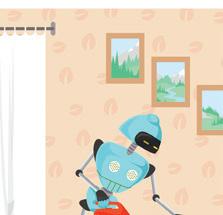
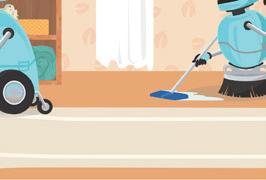


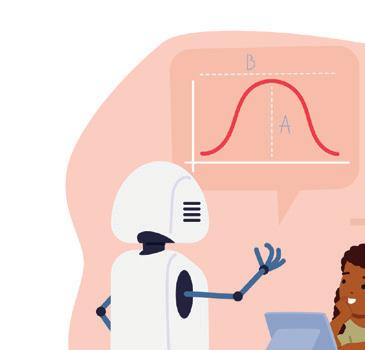
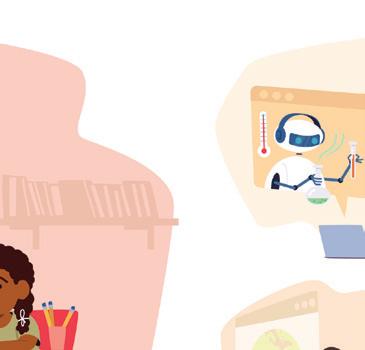


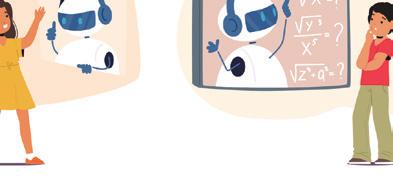
AI helps in hospitals as follows:
AI in healthcare: Finds diseases and making medical reports.
AI chatbots: Provide medical information, book appointments, and remind patients to take their medicine.
AI helps at shops as follows:
AI in shopping: Observes customer choice and suggests products.
AI in stocks: Keeps track of stocks.
AI chatbots: Answer questions, assist with returns, and resolve issues.
AI helps at railway stations and airports as follows:
AI in travel: Provides real-time updates on train and flight schedules and delays.
AI in security: Checks video cameras to detect unusual activity and enhance safety.
AI helps in banks as follows:
AI in customer service: Handles routine questions, transactions, and accounts.
AI in loans: Speeds up loan approvals by checking customers information and risks.

AI helps in restaurants as follows:
AI in placing orders: Suggests dishes based on previous orders.
AI in stocks: Keeps track of stock of food.
Do It Yourself 8A
Rewrite the jumbled words correctly.
a sastitsna
b bchoatts
c cireusty
Materials Required: Webcam and Speaker
1. Visit this link with the help of your teacher: https://my.aiclub.world/emotion-detect
2. You will see the page: Emotion Detection

3. Before starting the activity, you have to turn on your camera.
4. Once you turn on the camera, the AI gets ready to detect your emotion.

5. According to your mood, it will give a prompt. It will speak aloud using the speaker and also mention your mood in writing.

6. Try with different expressions and explore more.
1 AI stands for Artificial Intelligence, which is an application that makes computers and robots learn, think, and respond like humans.
2 AI is used at different places such as at homes, in schools, in hospitals, in restaurants, at railway station and airports, etc.
3 AI assistants like Siri and Google Assistant help us with various tasks, answer questions, and play music.
A. Fill in the blanks.
1 AI in handles routine questions, transactions, and accounts.
2 Smart assistant like can answer your questions and play music.

3 At shops, AI helps keep track of of food.
4 In hospitals, AI helps by finding diseases and making reports.
B. Tick () the correct option.
1 What does AI stand for?
a Automated Intelligence
c Advanced Interaction
2 How does AI help in hospitals?
a By cooking meals
c By managing inventory
3 What does AI in shopping do?
a Keeps track of food supplies
c Detects diseases
4 What is the role of AI in healthcare chatbots?
a Handle routine transactions
c Monitor video cameras
C. Write T for True and F for false.
b Artificial Intelligence
d Automated Interaction
b By reminding people to take their medicine
d By cleaning floors
b Suggests products based on customer choices
d Speeds up loan approvals
b Provide medical information
d Suggest dishes
1 AI in schools is used to create new lessons rather than explaining them based on the student’s understanding.
2 AI in restaurants helps by suggesting dishes based on previous orders.
3 AI in banks does not handle transactions or accounts.
4 AI at railways provides updates on train arrivals and delays.
D. Answer the following questions.
1 What is AI?
2 How does AI help at homes?
3 How does AI helps customers in shopping?
4 How does AI helps at airports?
E. Apply your learning.
1 Write the name of the place where the robot does the following.



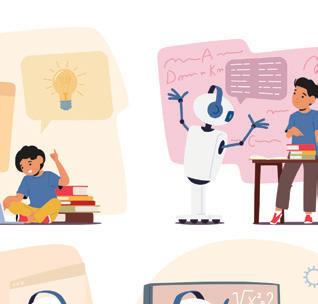
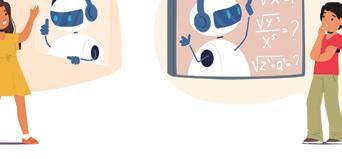

2 Find any 10 differences.

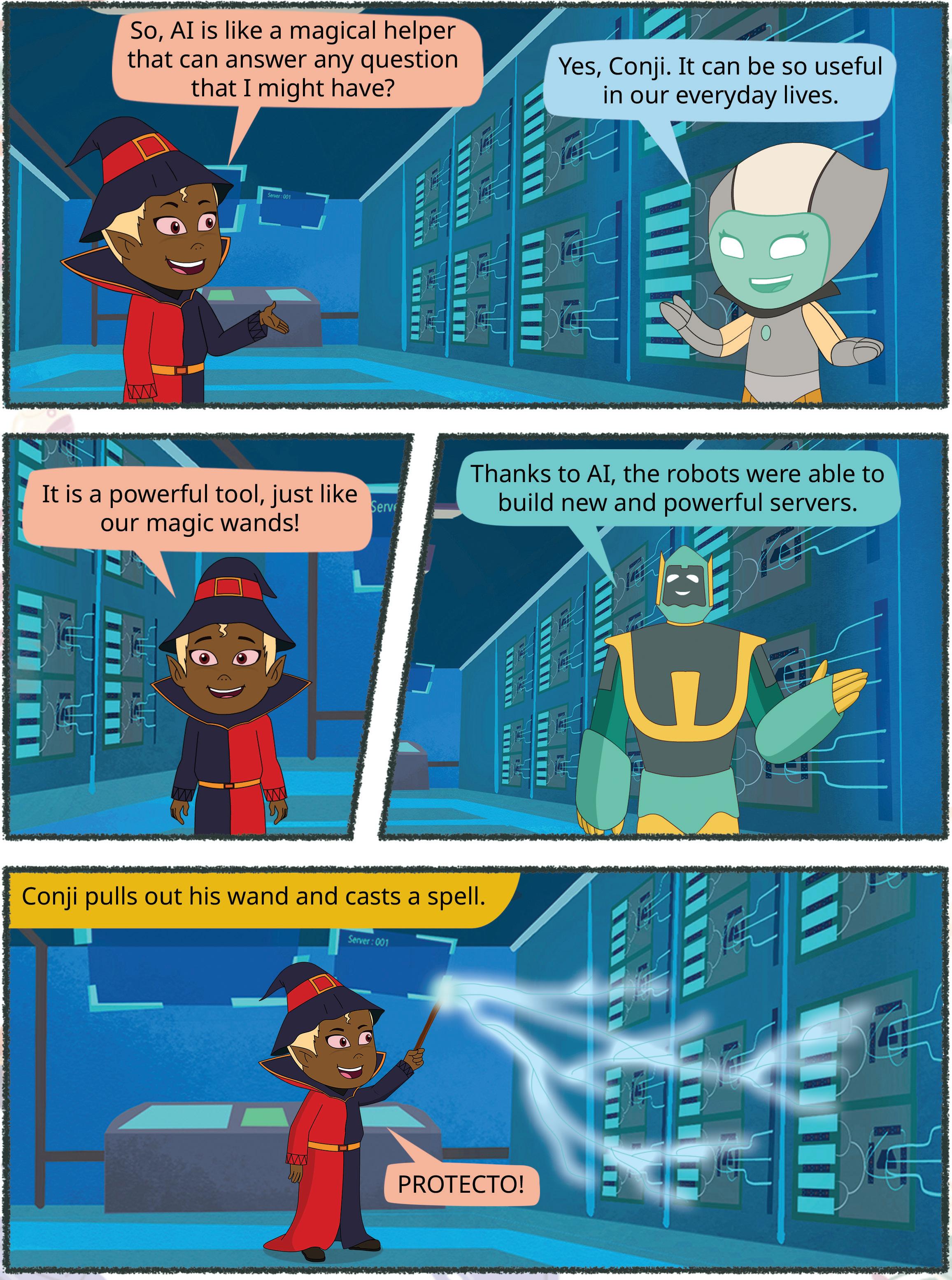


A. Fill in the blanks.
Hints:
hardware motherboard software website folders
1 The is the backbone of a computer system.
2 The operating system manages computer and .
3 A is a collection of web pages that contain information about a related topic.
4 can be used to organise files and make it easier to find them.
B. Tick () the correct option.
1 Which device allows you to hear music and sounds from a computer?
a Screen
b Microphones
c Mouse d Speakers
2 Which sorting option sorts your icons by the date they were last modified?
a Size
c Type
b Date modified
d Name
3 What is the blinking black line that appears on the white area called?
a Cursor b File
c Folder
C. Write T for True and F for False.
1 There are two main components of the CPU.
d Icon
2 The Search bar is used to find files, programs, settings, etc., on the computer.
3 Email is a way to send messages to people over the internet.
4 A file is a collection of folders.
D. Answer the following questions.
1 What is processing?
2 What are icons?
3 Write any two advantages of internet.
E. Apply your learning.
1 Sejal’s mother is controlling a device by using her finger tips instead of a mouse or keyboard. Name the device which she is using.
2 Ayushi wants to search for the “Calculator” application on her computer. How can she do it?

3 Neha shared her personal information with a stranger over the internet. Was it a good thing to do? Give your reason.

A. Fill in the blanks.
Hints:
1 The shows the name of your drawing.
2 is an application that makes computers and robots learn, think, and respond like humans.
3 You can select a paragraph by anywhere on the paragraph.
4 Smart assistant like can answer your questions and play music for you.
B. Tick () the correct option.
1 Which one of the following tools in Paint will you use to draw a freehand drawing?
a Pencil
c Eraser
2 In a document tab, ‘X’ sign is used to:
a Save the document
c Close the document
3 Moving a text involves the commands:
a Cut and Paste
c Delete and Paste
C. Write T for True and F for False.
b Rectangle
d Text
b Open the document
d Share the document
b Copy and Paste
d Select and Copy
1 A callout is a shape that is used to write a message.
2 Autosave is a feature of Google Docs that automatically saves an open document or file.
3 Pasting text means duplicating the selected text and making it available for another location.
4 AI in shopping helps by suggesting products based on customer preferences.
D. Answer the following questions.
1 What is the use of the Color picker tool?
2 Define word processor.
3 How can you delete text in Google Docs?
E. Apply your learning.
1 Ashi wants to write “Welcome to the dreamland” on the drawing she drew. Which tool will help her write text in the drawing?
2 Rahul wants to have the same word in another place in his document. What should he do?
3 Shivam is working on a document on Google Docs and is worried about losing it. How can he save it?

This book embodies the principles outlined in the National Curriculum Framework (NCF) and the National Education Policy (NEP) 2020. It unveils the world of computer science through a unique and captivating pedagogical approach— seamlessly integrating curriculum content into the mesmerising adventures of Mel and Conji, fictional figures hailing from the enchanting world of Avora. Our aim is to prepare learners for the dynamic and technology-driven landscape of the 21st century, equipping them with the essential skills they need to thrive in an ever-evolving world.
• NEP Tags: To showcase alignment with NEP skills and values.

• Explore More: QR codes to explore an exciting application of the concept.
• Discuss: Questions to trigger engaging group discussions in the classroom.
• Think and Tell: Probing questions to stimulate thinking at an individual level.
• Did You Know? Interesting facts related to the application of a concept.
• Fun with AI: Engaging AI activities to explore and apply AI concepts in practical ways.
• Do It Yourself: Milestone exercises to practice specific concepts.
• Chapter Checkup: A pool of questions catering to all topics and skills covered in the chapter.
• Test Papers: Designed to evaluate understanding of core concepts and application of skills.
Uolo partners with K-12 schools to provide technology-enabled learning programs. We believe that pedagogy and technology must come together to deliver scalable learning experiences that generate measurable outcomes. Uolo is trusted by over 15,000+ schools across India, Southeast Asia, and the Middle East.
ISBN 978-81-978912-4-3
